Volvo EX30 Performance review
Volvo has a reputation for making safe and reliable vehicles, which are more luxurious than the average car but more boring than what the premium makers offer. Yet the newest addition to its lineup - the EX30 - aims to shake things up. If ever there was a car to challenge the boring Swedish manufacturer notion - it is certainly the compact SUV that is quicker off the line than even some supercars.

Table of Contents:
- Exterior
- Interior
- Storage & practicalities
- Driving experience
- Tech features
- Ride comfort
- Cabin noise
- Acceleration and braking
- Consumption
- Charging speed
- Competition
- Verdict
The model we are testing is the Volvo EX30 Twin Motor Performance in the highest possible "Ultra" trim. This is the fastest accelerating Volvo ever produced, while at the same time being also the most eco-friendly thanks to primarily using recycled materials. The EX30 shares a platform, powertrain and battery with the Zeekr X and is closely related to the Smart #1 and Smart #3.
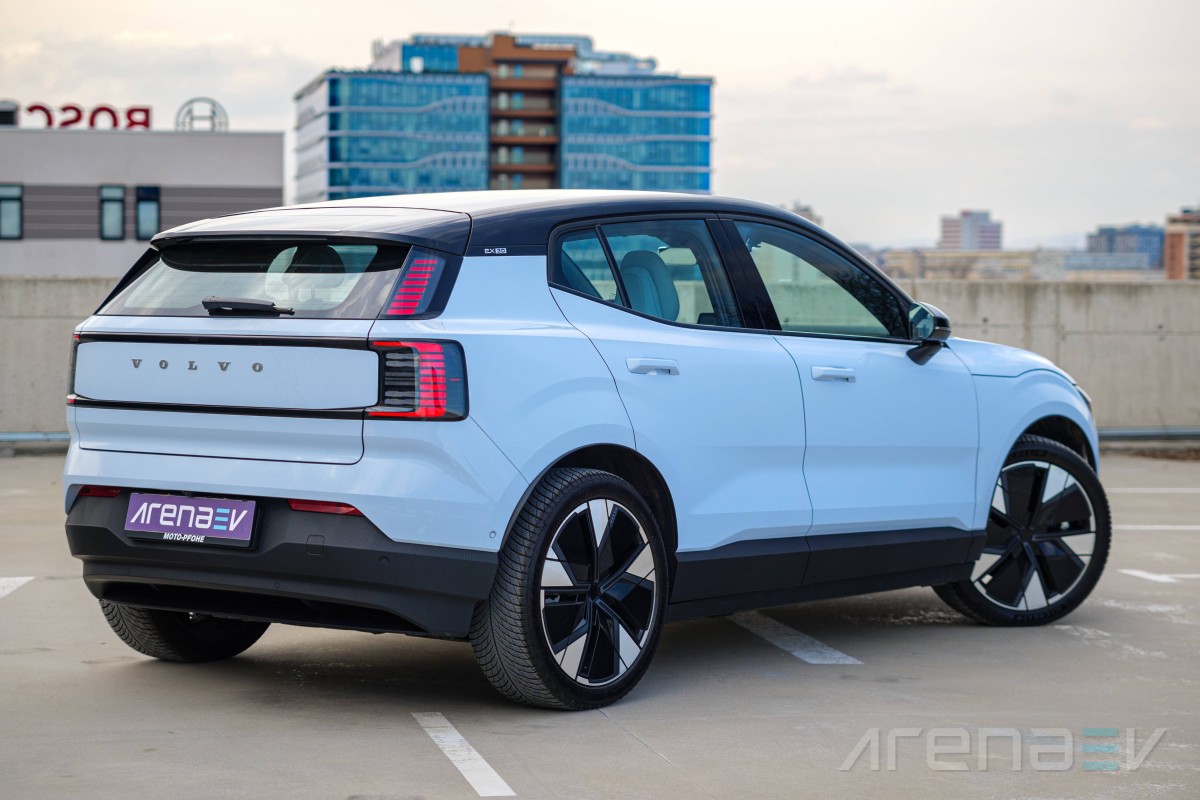
The Volvo EX30 Performance is promises to deliver speed, comfort and usability, all in one compact package that is easy to get around the city. Its slogan is "a not so big, big deal" and on paper it looks very fitting, but we'll now set off to test it and find out just how good it actually is in the real world.
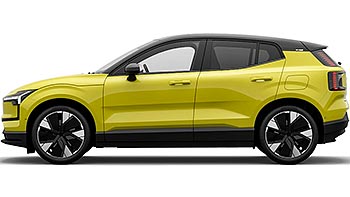
Volvo EX30 Twin Motor Performance 2023 -
- Dimensions: 166.7 inches x 72.3 inches x 61 inches, 104.3 inches wheelbase.
- Drivetrain tested: Twin Motor Performance - AWD 315 kW (428 hp), 400 lb-ft, 69 kWh total battery capacity, 64 kWh usable battery capacity
- Other drivetrains: Single Motor - RWD 200 kW (272 hp), 253 lb-ft, 51 kWh total battery capacity
- Charging: 153 kW CCS; 10-80% in 25 min.
- Range: 286 miles WLTP (275 miles EPA)
- Weight: 4,284 lb unladen, 5,154 lb gross
- Other features: Air purifier, Google services, OTA updates.
Exterior
The Volvo EX30 is a compact SUV, but it also looks beefy and muscular. It retains signature elements from previous Volvo models, so it's an instantly recognizable product of the Swedish maker. The EX30 follows a minimalist approach both on the outside and the inside, removing anything that’s not vital to the operation. The result is a clear and simple look on the outside with no disturbing lines or clutter.
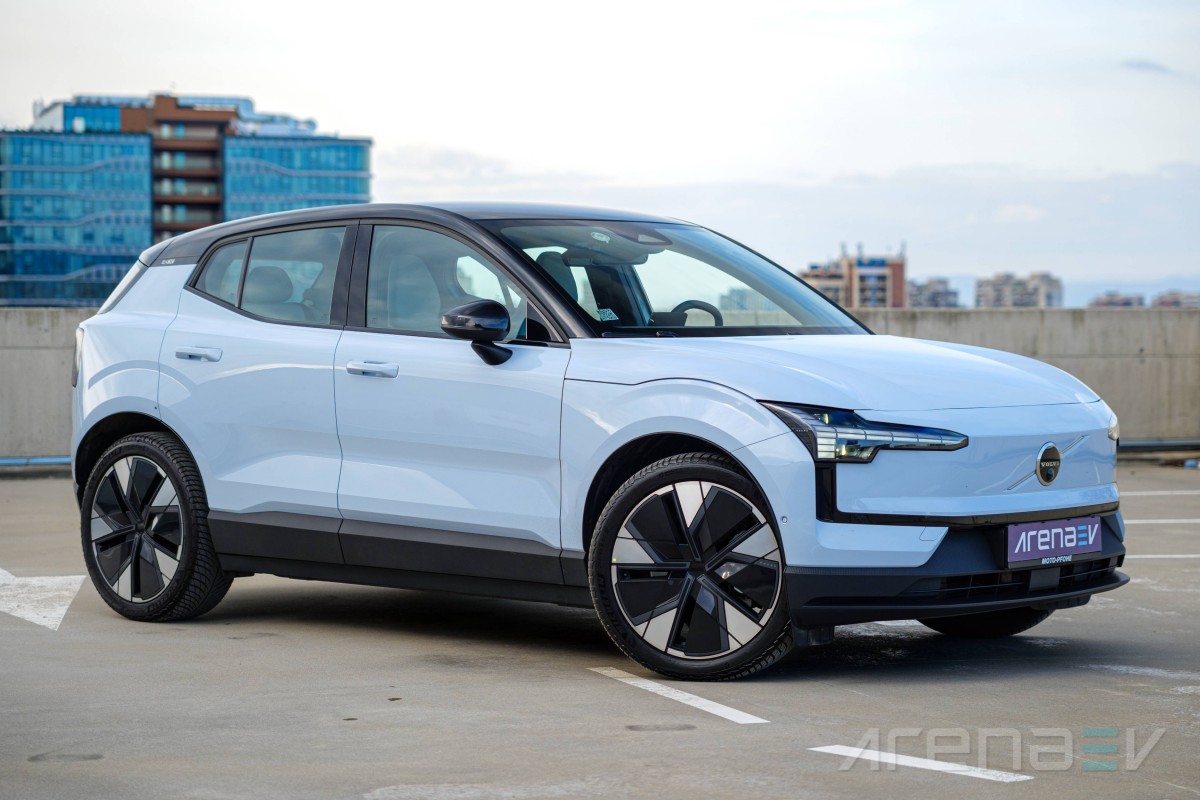
At the front the EX30 has a giant front badge and the signature "Thor’s hammer" headlights. One of the most successful product to come out of Volvos's design studio these are inspired by the mythological Mjolnir, which is a symbol of power and greatness in Scandinavian countries.
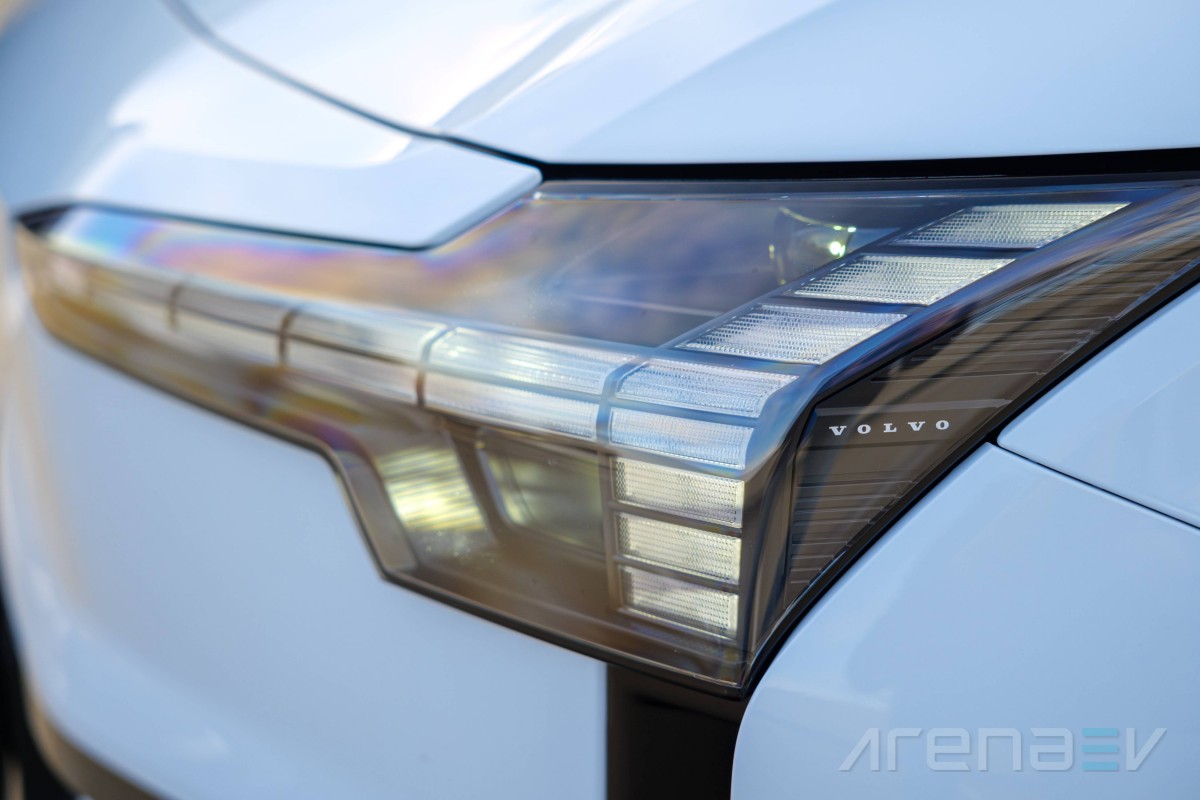
The headlights have a menacing look at night, but during the day they appear tame and sophisticated. They go well with the EX30's subtle body lines too.

The Volvo EX30 makes do without a traditional grille, but gets some vent openings in the lower part of the front for additional cooling when needed. They are carved into the plastic black trim lines, which surround the whole body of the EX30. These trims give the EX30 a more rugged appearance, but most importantly are cheaper to replace if you happen to scrape them against the sidewalk or otherwise damage them.
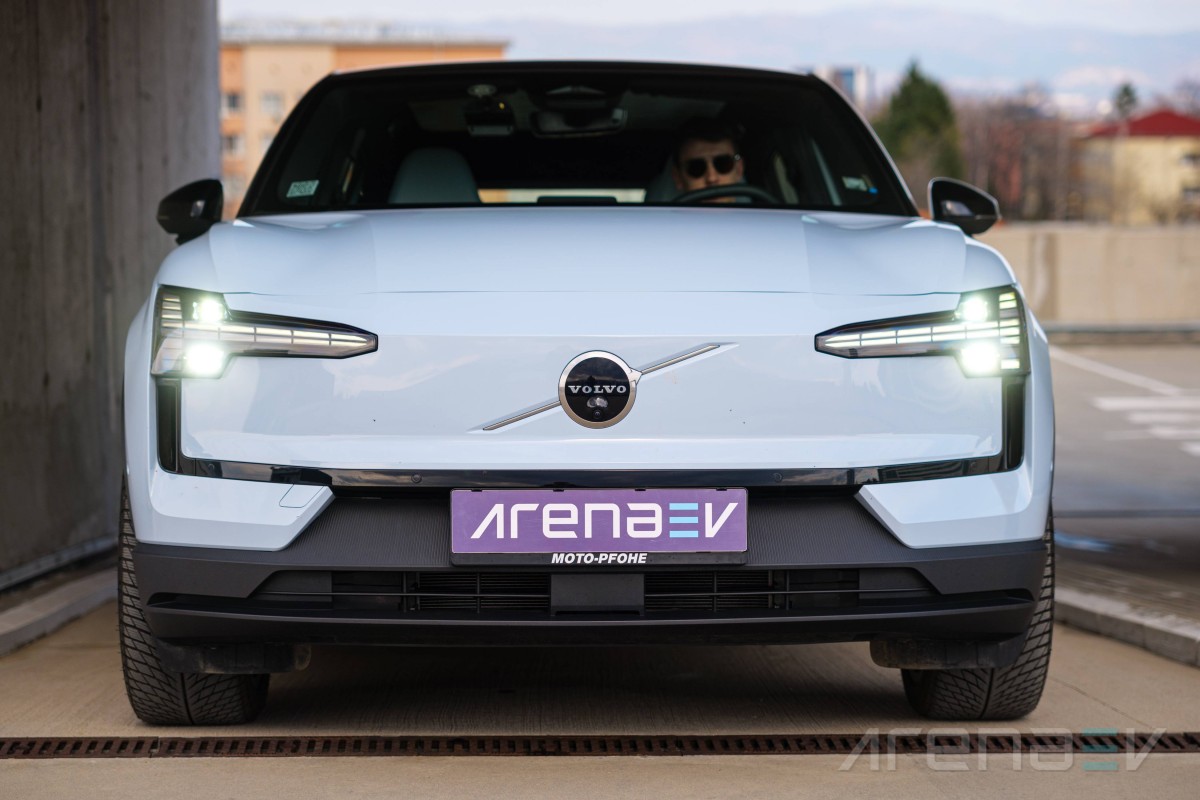
From the side, the EX30 has the lifted stance and body panels of an SUV, the size and design of a compact hatchback and the proportions of a minivan. This makes it quite distinct and a breath of fresh air in a world of copycat compact crossovers.

The wheels and tires are huge for such a small vehicle. Our EX30 came equipped with the optional 20-inch 5-spoke wheels, which almost look cartoonish on a vehicle of this size. The wheels lack a logo in the center, trading it for a subtle "Volvo" inscription on one of the spokes.
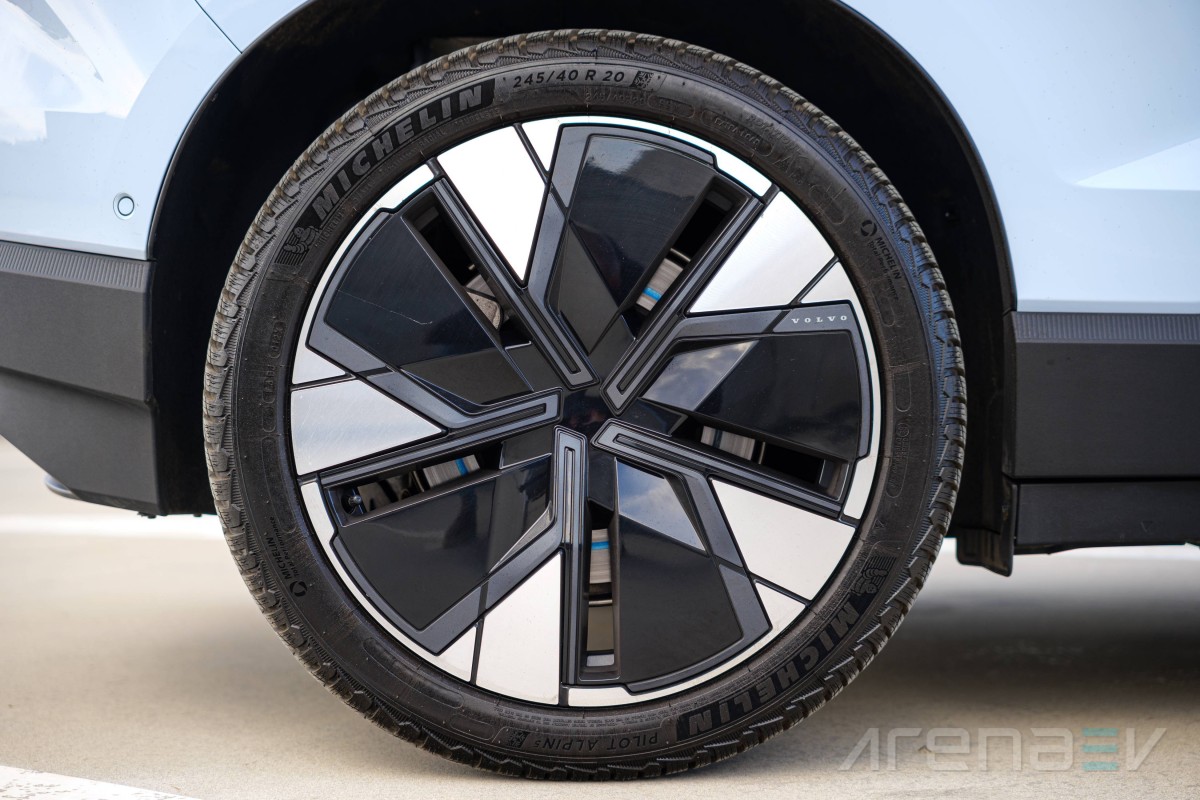
A fantastic feature Volvo and Polestar recently adopted are the frameless wing mirrors, which give off an extremely upmarket feel to their cars.
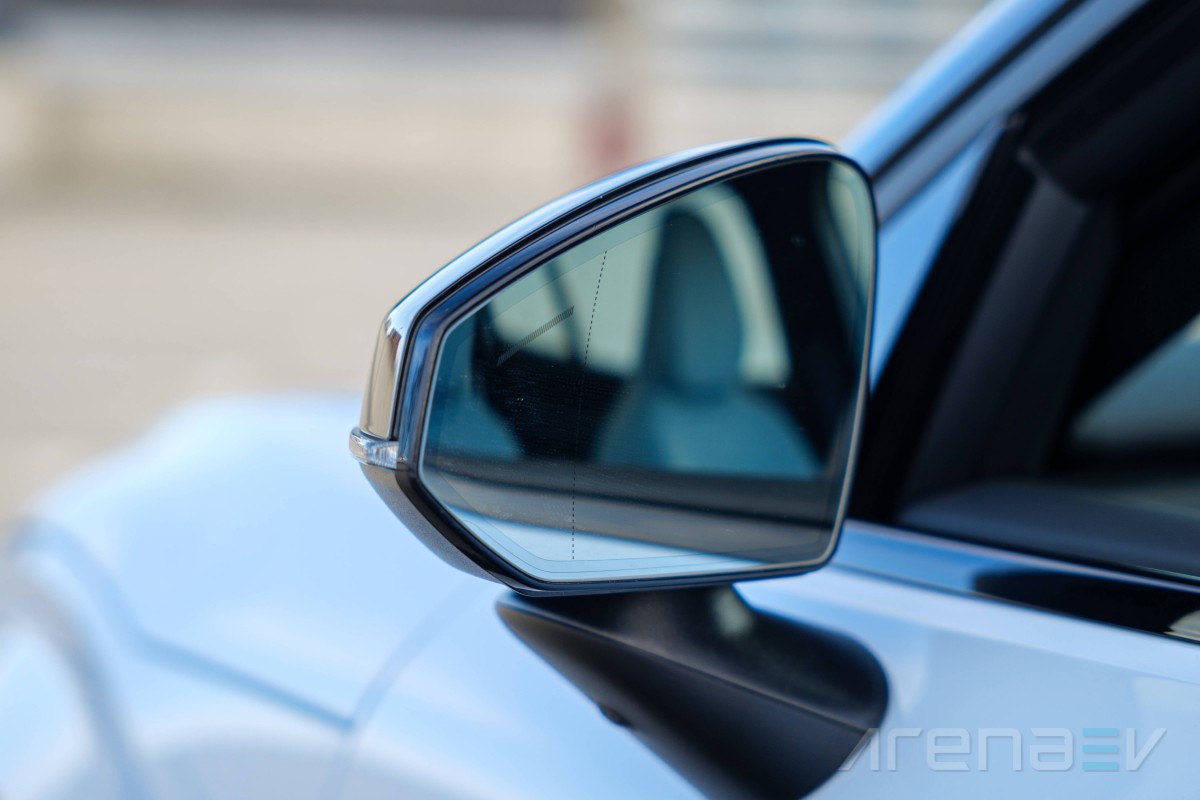
The EX30 luckily has normal door handles and our unit also came with the optional keyless lock and unlock. In our experience the keyless tag didn't work very reliably with the car refusing to lock and unlock on occasion. Worse yet, it has no key to manually trigger so you need to walk back and forth and repeat the process.
When using the regular credit card-shaped key you can only use the driver's door to enter. The system is significantly worse than what Volvo used to offer in the past and while we get that it saves on manufacturing costs, it also drastically impacts convenience.
Volvo says those with keyless entry will be able to use their phones eventually (in fact it's only distributing the fob as a stop gap as it works on pushing the functionality through an update). We just hope that also addresses the reliability of the system.
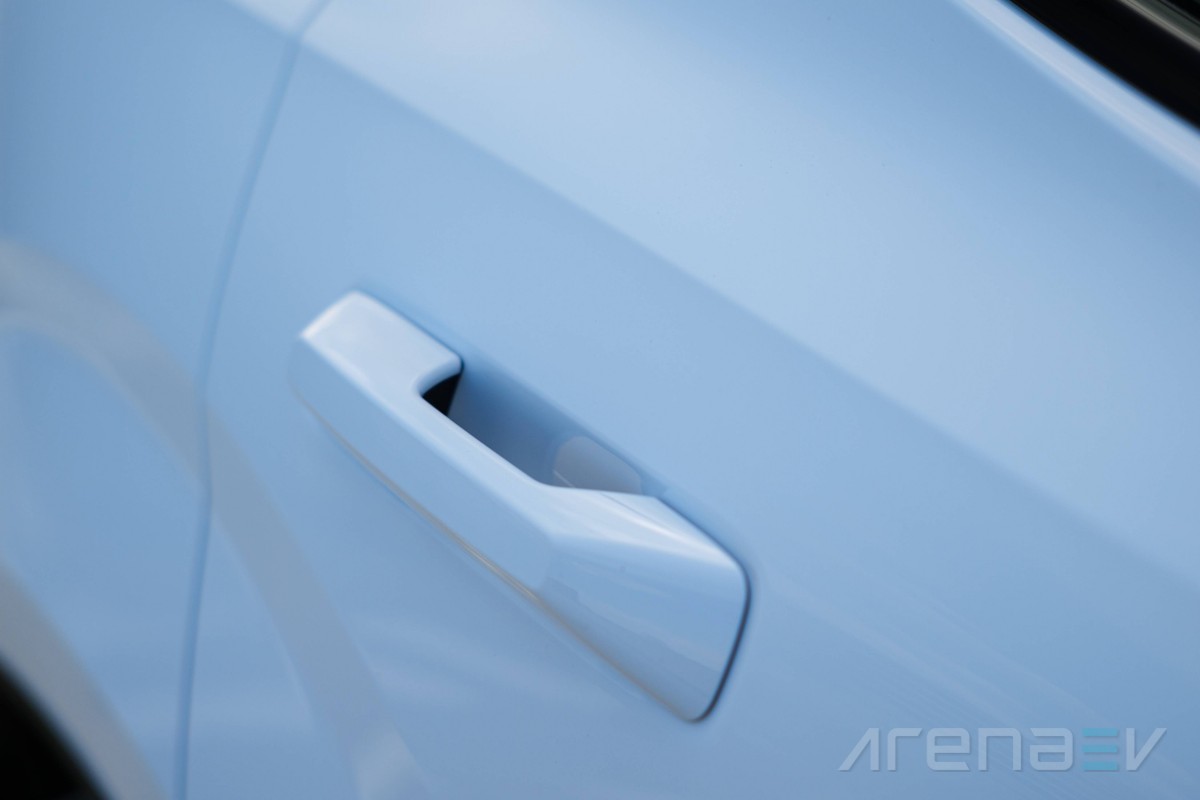
The two higher trims come with a black roof lining that makes the EX30 appear more sporty and lowered to the ground. This also adds a glass roof, which sadly doesn’t open and remains clear at all times, meaning sunny summer days might make the interior too bright. The glass handles heat well, but it still allows sun rays in. At the edge of each C-pillar is a small "EX30" sign, which is the only place where the model is labeled on the exterior.
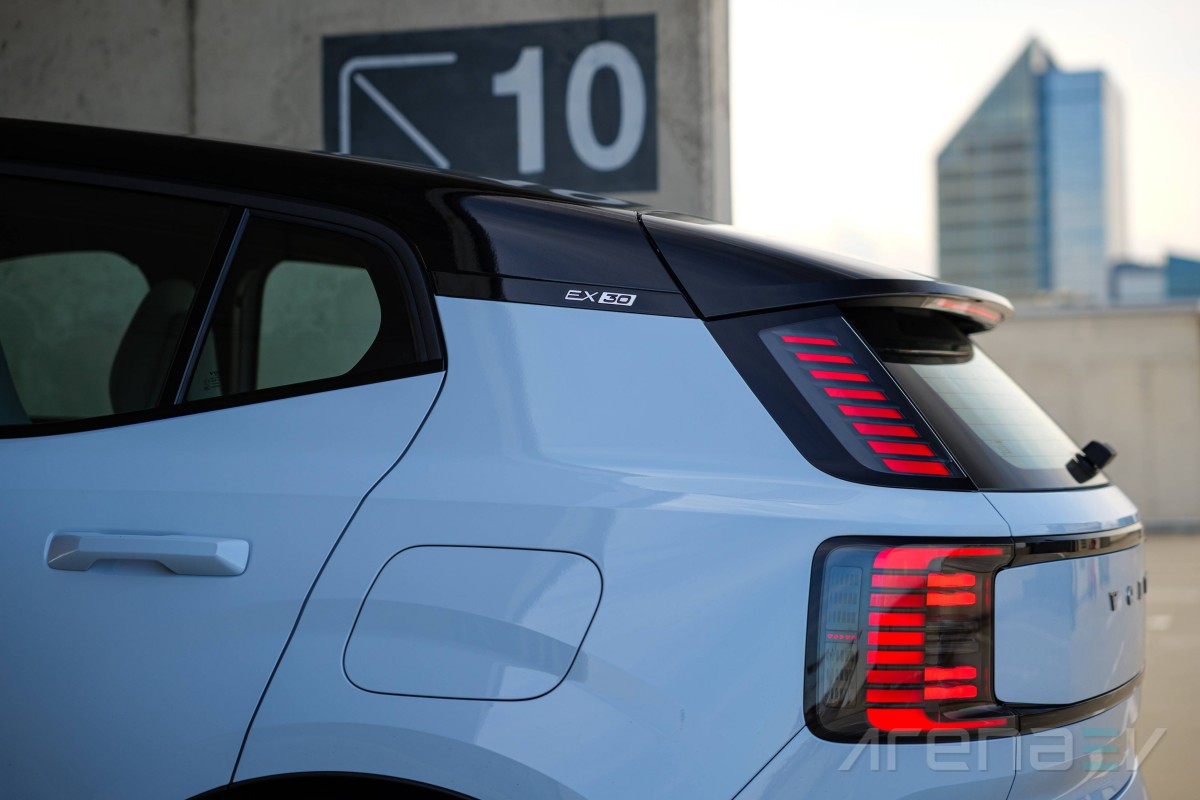
The back of the Volvo EX30 has a lot of edges, combined with curvy lines to create a distinct look. The tail lights are split into two, but the upper parts are solely decorative and light up only as tail light extensions.

The most notable design feature around back are the two bars, which connect the tail lights. They do not light up, but incorporate the trunk opening button so that it doesn’t disturb the overall look.
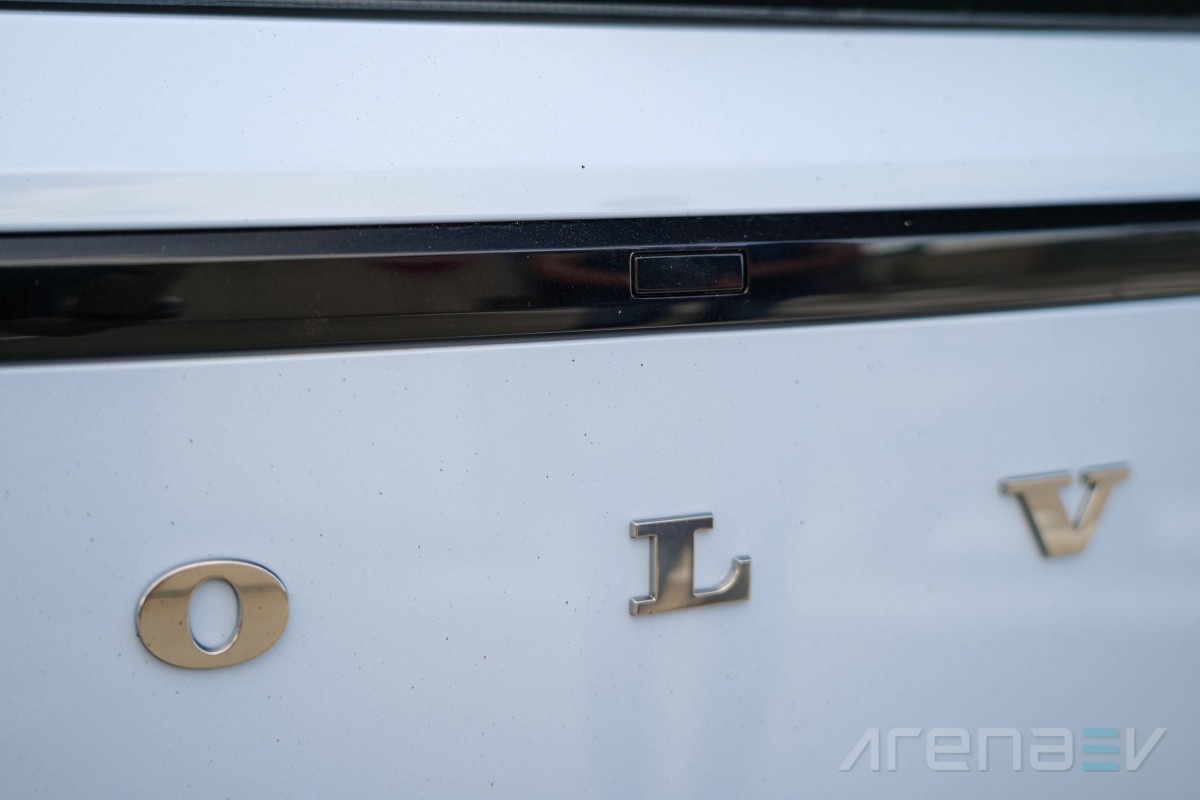
Between the rear bars sits the prominent Volvo inscription. It is accompanied by two very little Volvo labels inside the tail lights that can be only be spotted from up close.
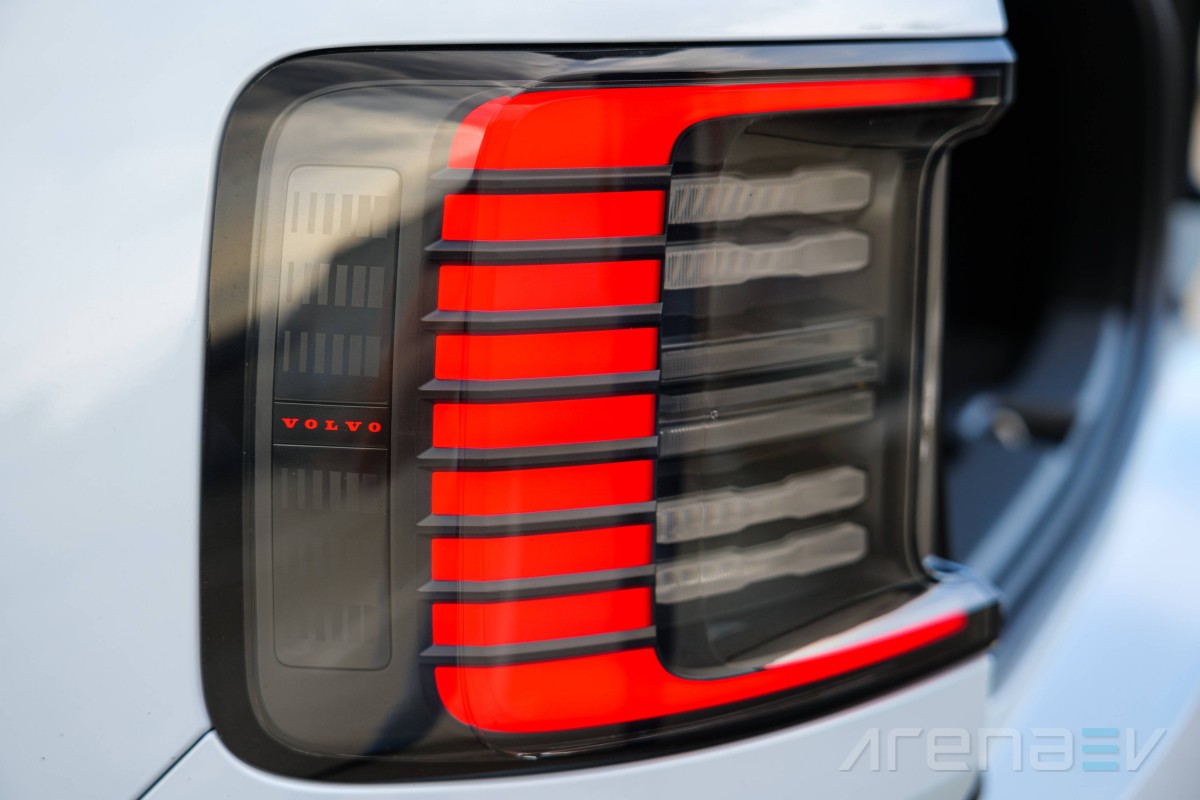
Interior
The inside of the EX30 is, as you'd expect from a Volvo, cold and simplistic. There are some exceptionally fine materials, combined with some of the worst possible plastics ever produced. We appreciate the interior being entirely made up of recycled materials, yet some of them simply do not belong in any vehicle. The built quality, however, is sensational and every surface gives off the impression as though it would never ever creak or rattle.
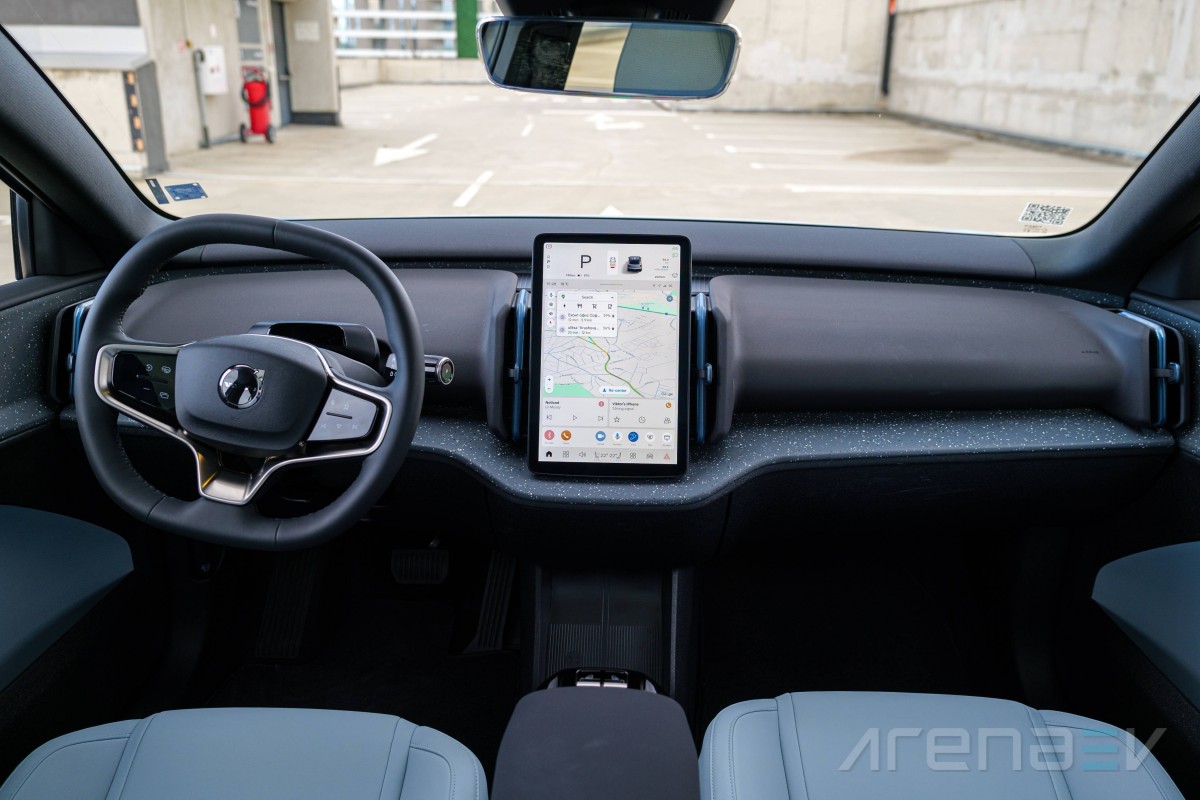
Our test car had the light blue "Breeze" interior, which looks alright in photos, but we'd probably prefer one of the other options if we were buying the EX30. It comes with scattered dots lining the dash and the doors, which makes them appears as they are stained at first. Once that washes away you start looking at the "bus seat" pattern and wish you opted for some of the classier interior design options.
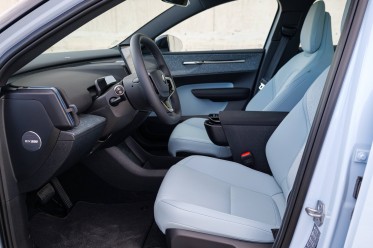
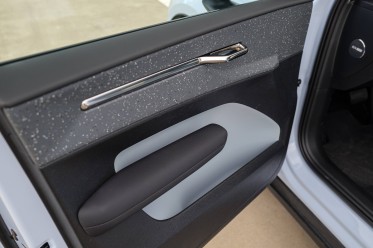
"Breeze" blue is probably not the best interior color option.
We found the blue seats very comfortable, though. They offer little side and thigh support, but they are well-suited for longer drives and the optional heating works quickly. Adjusting the seats takes some mastering, as it involves using a single unit for all corrections, but once you get the hang of it becomes very fast.
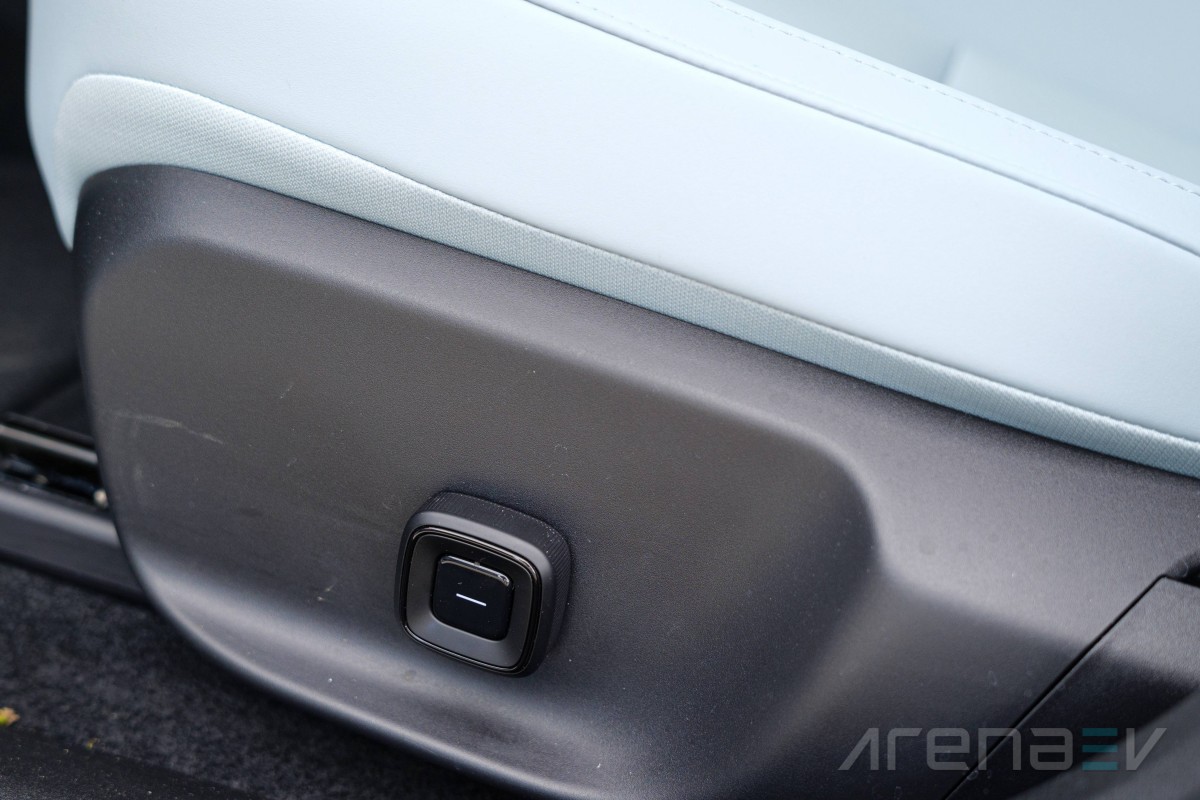
Once you prepare to drive you notice the absence of a gauge cluster or any sort of display in front of you. There is only a steering wheel, which is flattened at the top and bottom parts. Normally the top cut is done to improve visibility of the driver display or the head-up display, but the EX30 has neither of those.
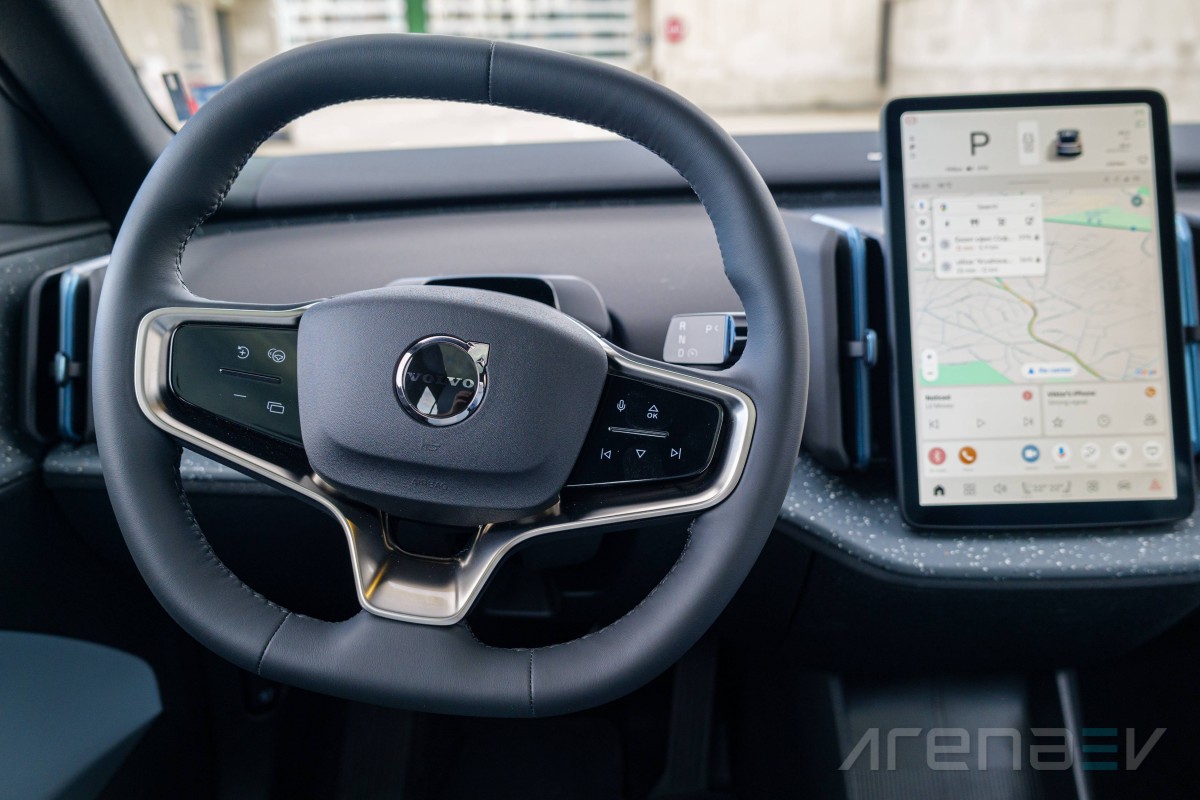
The buttons on the steering wheel feature both touch and regular press, which requires getting used to, but simplifies the overall look and controls. Functionality changes depending on the multimedia setting currently controlled.
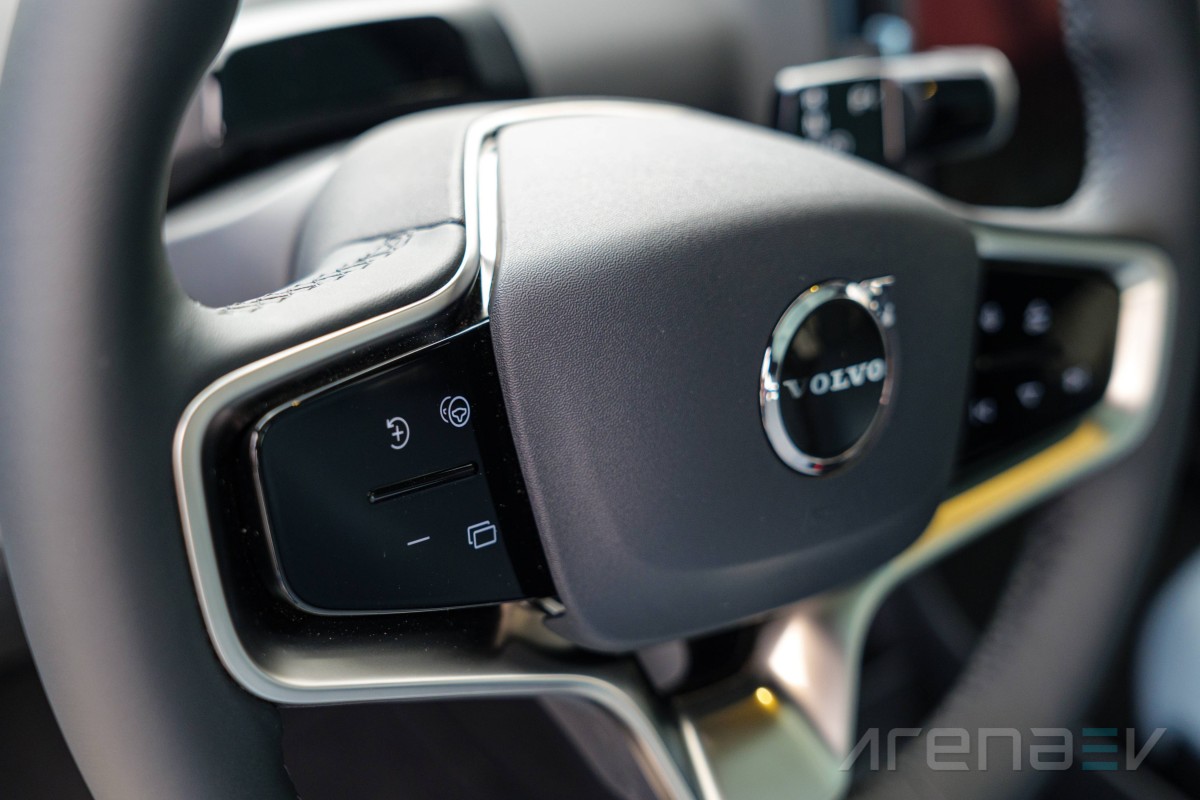
Behind the steering wheel is the blinker stalk, which looks and feels premium and wouldn't be out of place in a premium vehicle. Sadly, it is one of those stalks, which always gets into initial position after pressing. This makes it a bit unpredictable and is exactly the reason why most manufacturers stopped making stalks like that. On the right side of the steering wheel is the gear selector, which feels hefty and upmarket, just like the left stalk.
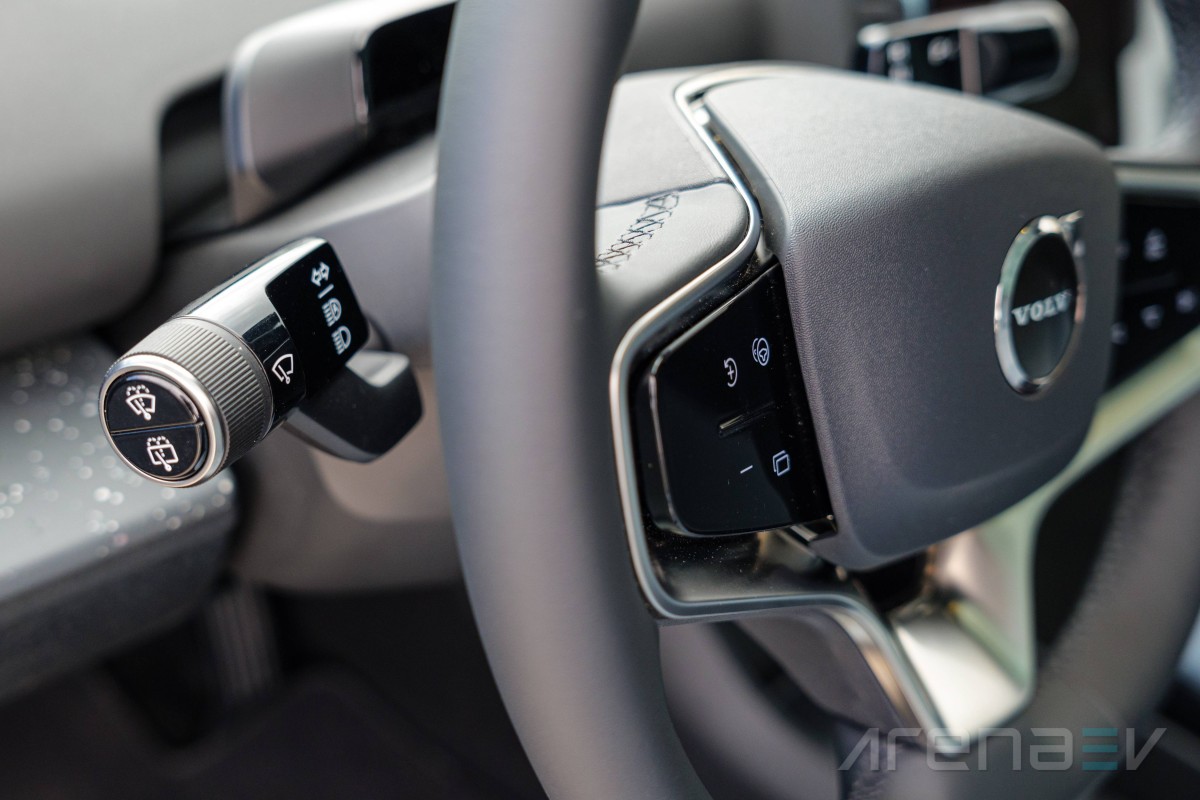
The middle of the dashboard is occupied by a 12.3-inch vertical center touchscreen, which is the only display in the EX30. It incorporates the functions of a gauge cluster, multimedia and climate controls. It is quick to respond and has amazing picture quality.
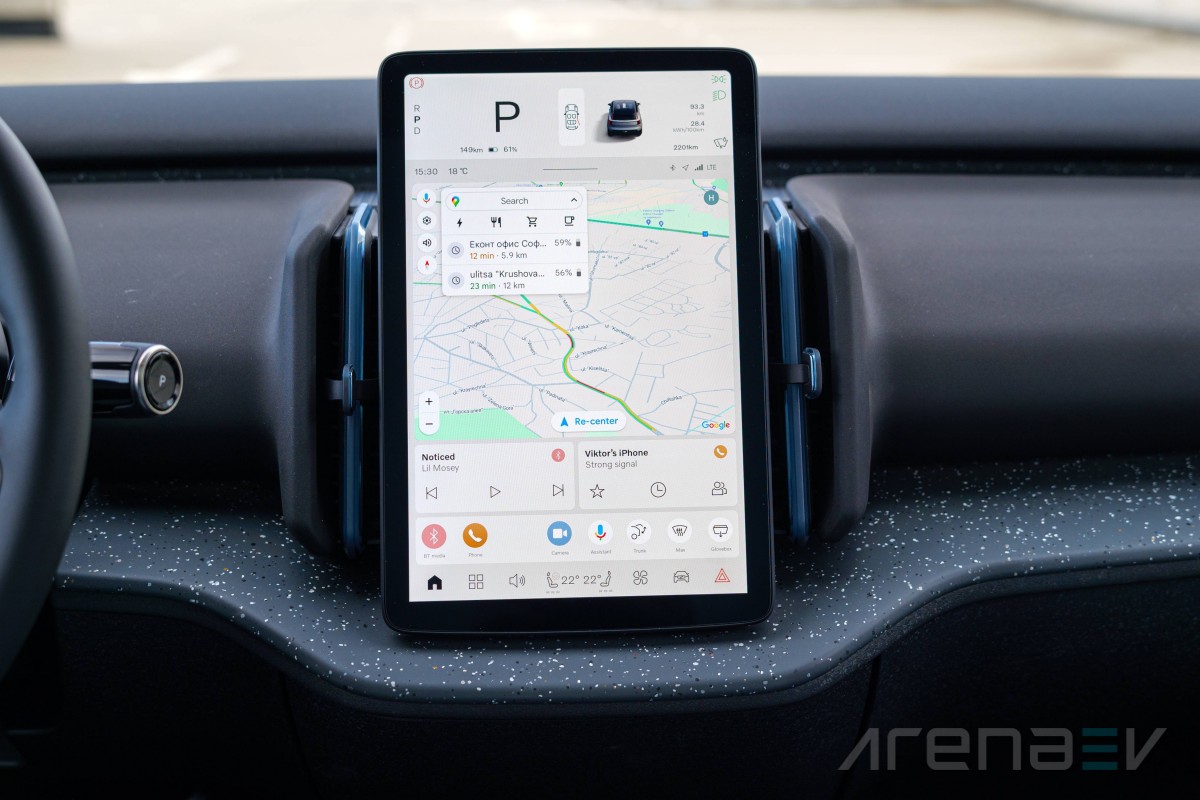
The display is surrounded by vertical climate vents, which have a bright blue inlet that looks like it will be a part of the ambient lighting, but isn’t. The lights themselves are somewhat dim and only highlight the dashboard in either yellow or white, creating a somewhat cold atmosphere.

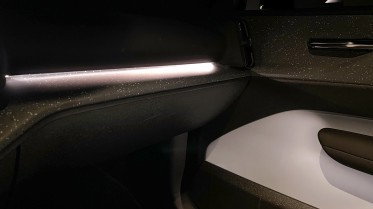
All the vents look like they're part of the ambient lighting, yet they aren't.
Right below the center screen is the glovebox, which is rather small. It can also only be open from the center screen, turing what should be a very straightforward process into a chore. The glovebox and all trim pieces around it are made up of the same recycled material, which looks and feels terrible and already had scratches in our test vehicle even though it had barely seen any running.
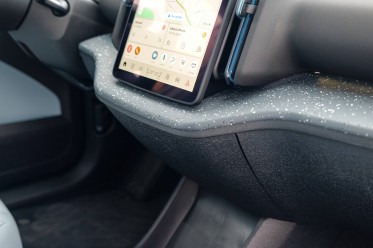
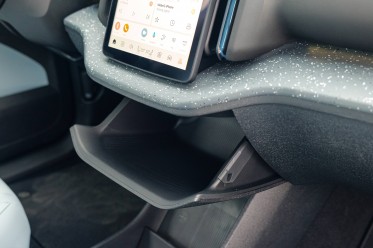
The glovebox is controlled from the touchscreen in the EX30.
The center console between the front passengers has several levels. The lower part is a vast empty space that can become even bigger by opening two door-like trays, which hide USB-C chargers and smaller storage compartments. There is also a wireless charging pad there, which actually works and doesn’t only heat up the phone - a real rarity.
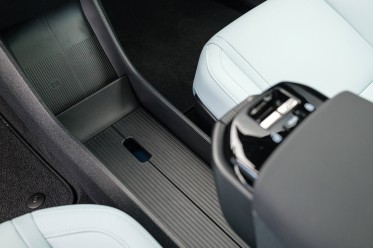

You can store both big and small items between the front passengers.
The upper part of the center console has the armrest, which doesn’t open up, but rather extends forward to reveal the cupholders. Above them are the window controls, which use the same unit for front and back, you just switch which one you wish to control. This is another prime example of complicating a simple procedure just to save on a couple buttons.
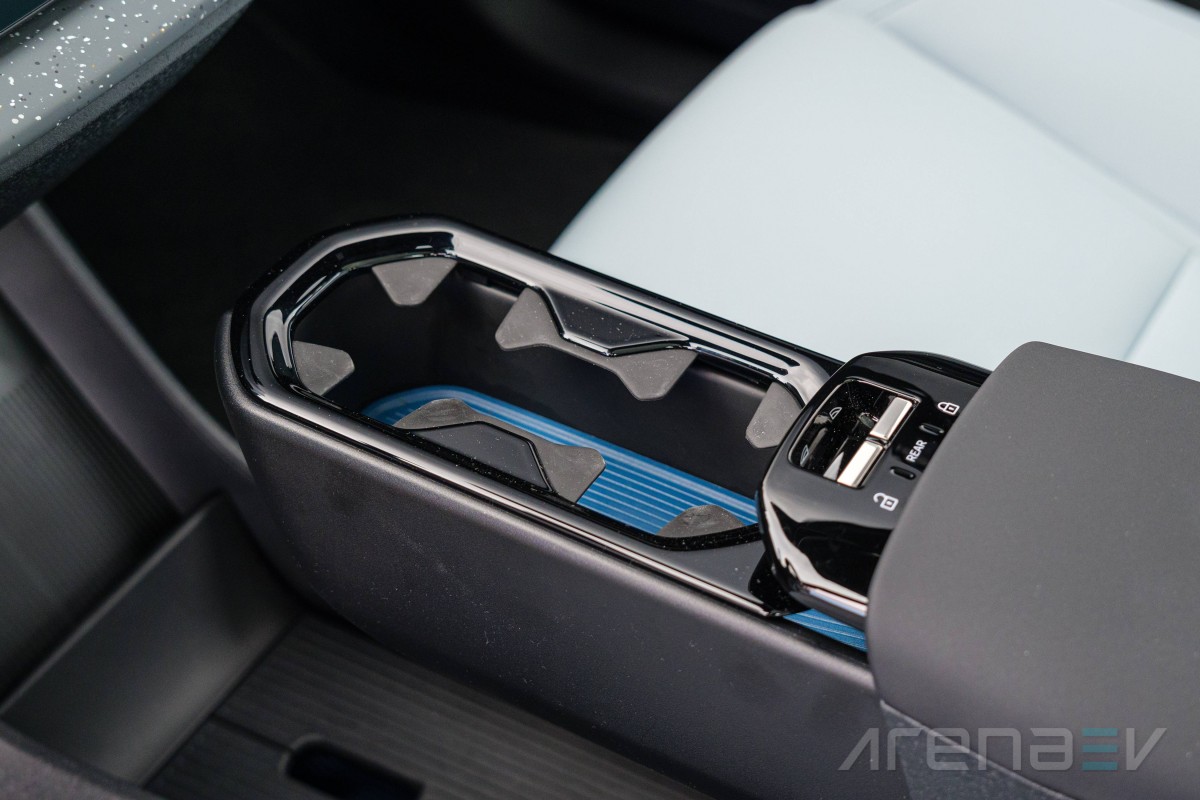
The doors have no controls or buttons, but offer some storage. The door handles are made of sublime thin chrome, which looks exquisite would be fitting even for a Bentley or a Rolls-Royce. Sadly, this fine piece is surrounded by the cheapest possible plastic of the door trim, taking away the initially great impression.

The rear seats are good for such a small vehicle and offer sufficient head and legroom. Our 1.95 m (6'4") tall reviewer fits if tightly, while anyone smaller will experience no discomfort even on longer trips. The rear occupants can store some items next to the seats, hidden away from the eyes of outside onlookers.

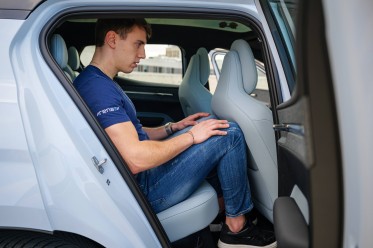
Taller passengers don't travel comfortably in the back of the EX30.
The rear offers no frills except for two USB-C charge ports and window controls. There is a deep storage pocket under the front center console. Once you take it out you see a cool graphic of a moose in a forest. This is completely pointless, but a neat quirk to remind you of Volvo's Swedish heritage.
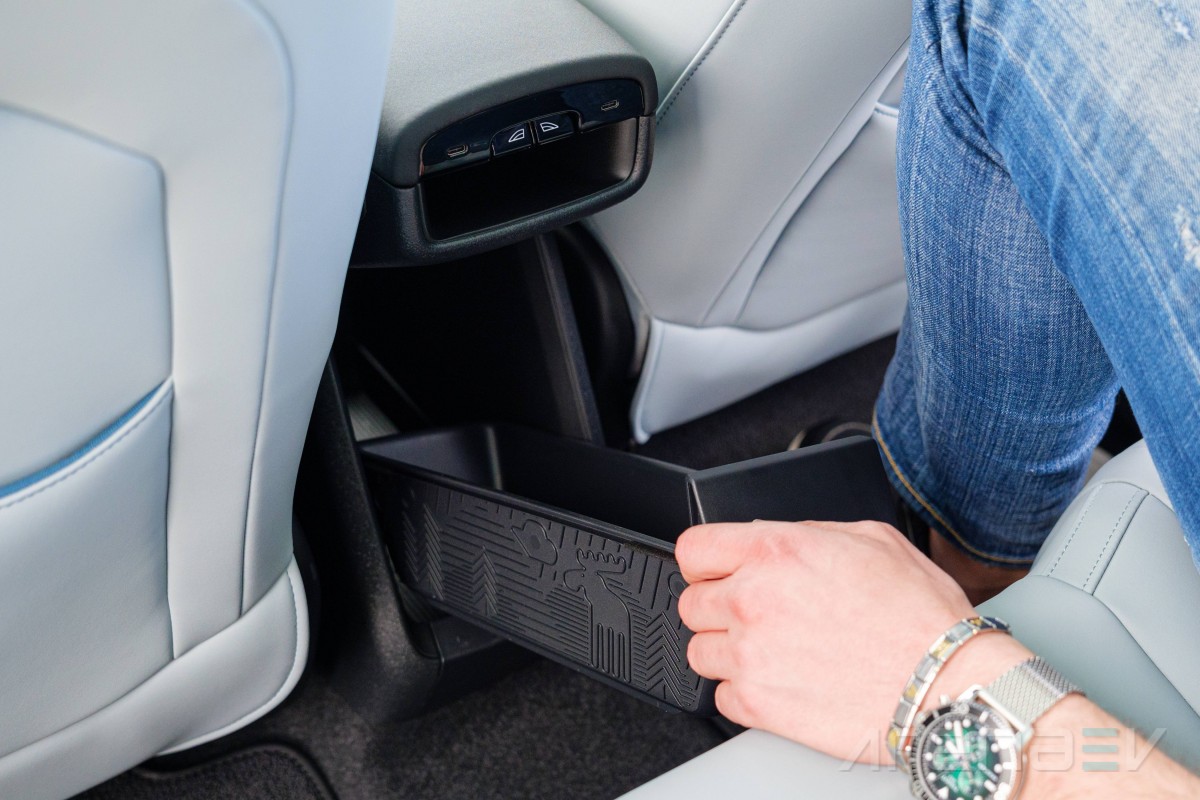
Storage & practicalities
Storage in the EX30 is not great even for its compact size with only 11.2 ft³ of trunk space. Most of the similarly sized mini SUVs offer more room albeit at the cost of more cramped second row seating. Volvo made a sacrifice in the trunk area, in exchange for the comfort or rear occupants, which we can definitely get behind.
If you need more storage and don't intend on carrying more than one passenger, you can fold down the seats, boosting the loading capacity to 31.9 ft³. If you are confused as to how to fit certain items inside, Volvo was kind enough to provide a comprehensive graphic on how some regular objects can fit.
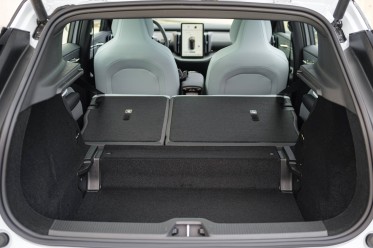
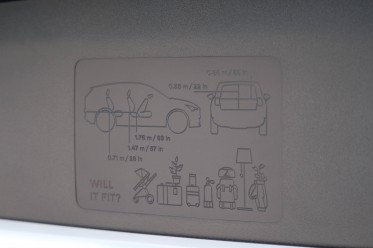
If you don't know how, Volvo will show you how to fit your items.
The Volvo EX30 also comes with a frunk (front trunk), but it is quite small and impractical due to its weird shape. You can still fit some seldomly used items to be out of your way in the main storage areas. The frunk cover doesn’t even latch in place, but it does comes with a graphic of an EX30 approaching a massive moose.
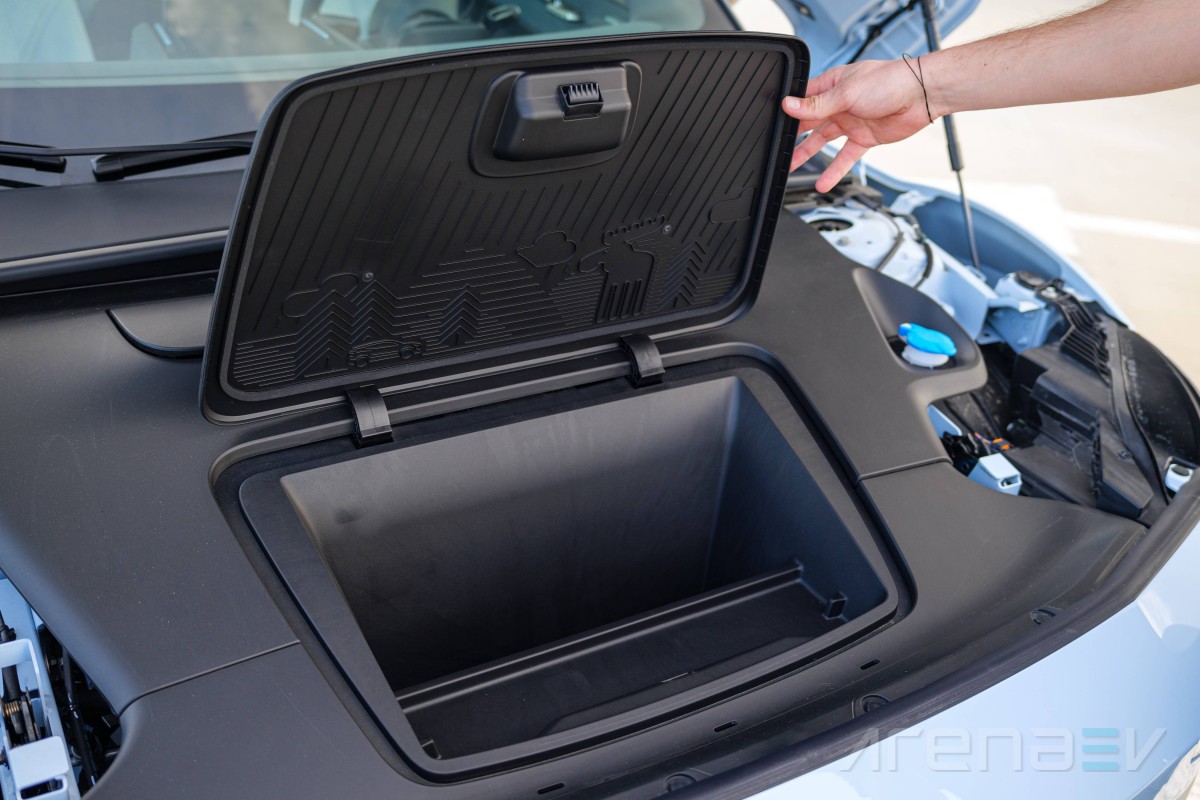
Driving experience
Volvo EX30 offers quite a unique driving experience, especially given the class it’s positioned in, where most vehicles offer just mundane transport from point A to point B. The EX30 Performance with its 428 hp can certainly get your pulse racing. Every drive is a joy and puts a big smile on your face. The car is quick in every situation and just pushes you to have fun behind the wheel.
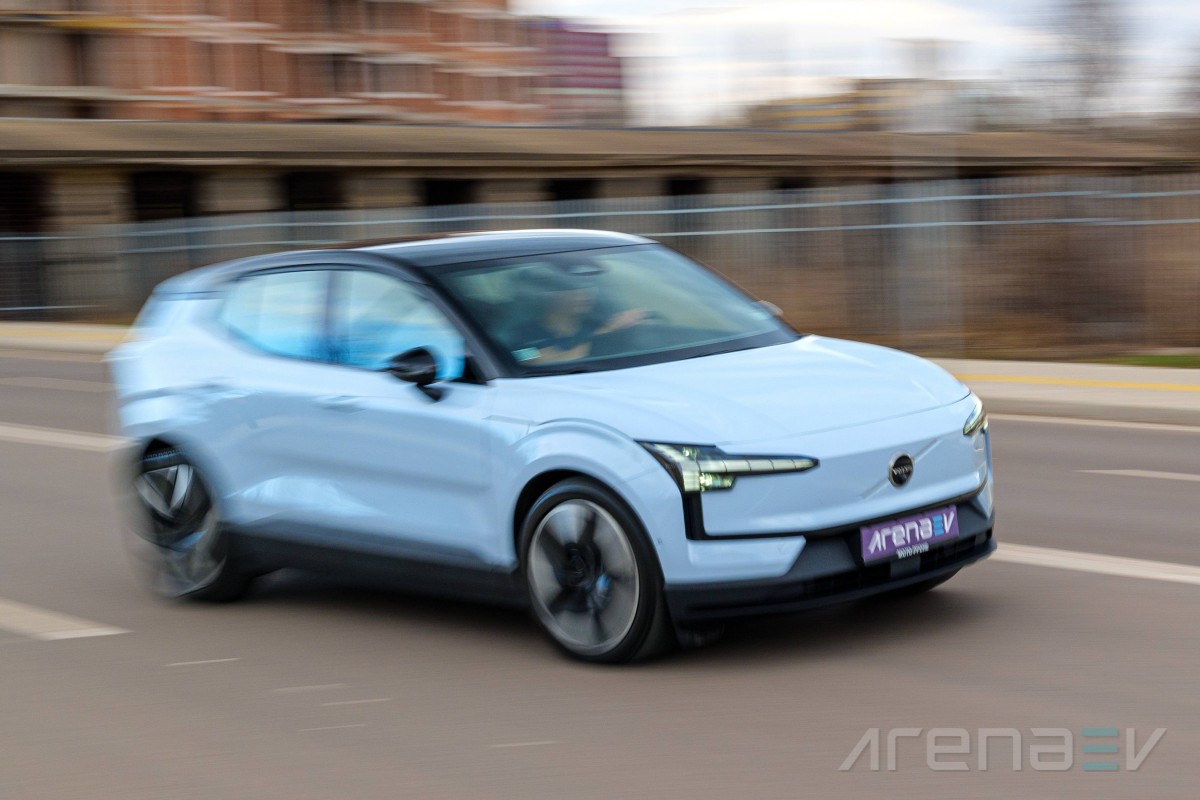
In regular city driving and at speeds of up to 62 mph, the EX30 Performance accelerates blisteringly quickly and zooms through traffic. It is small and nimble and can be easily maneuvered anywhere, even in very tight parking places. The default steering is light and lacking feedback, which is far from optimal for a spirited drive around corners, but enjoyable in a daily commute. The steering wheel tightness can be adjusted through the multimedia, but the changes are minimal so you can't really get a very sporty experience.
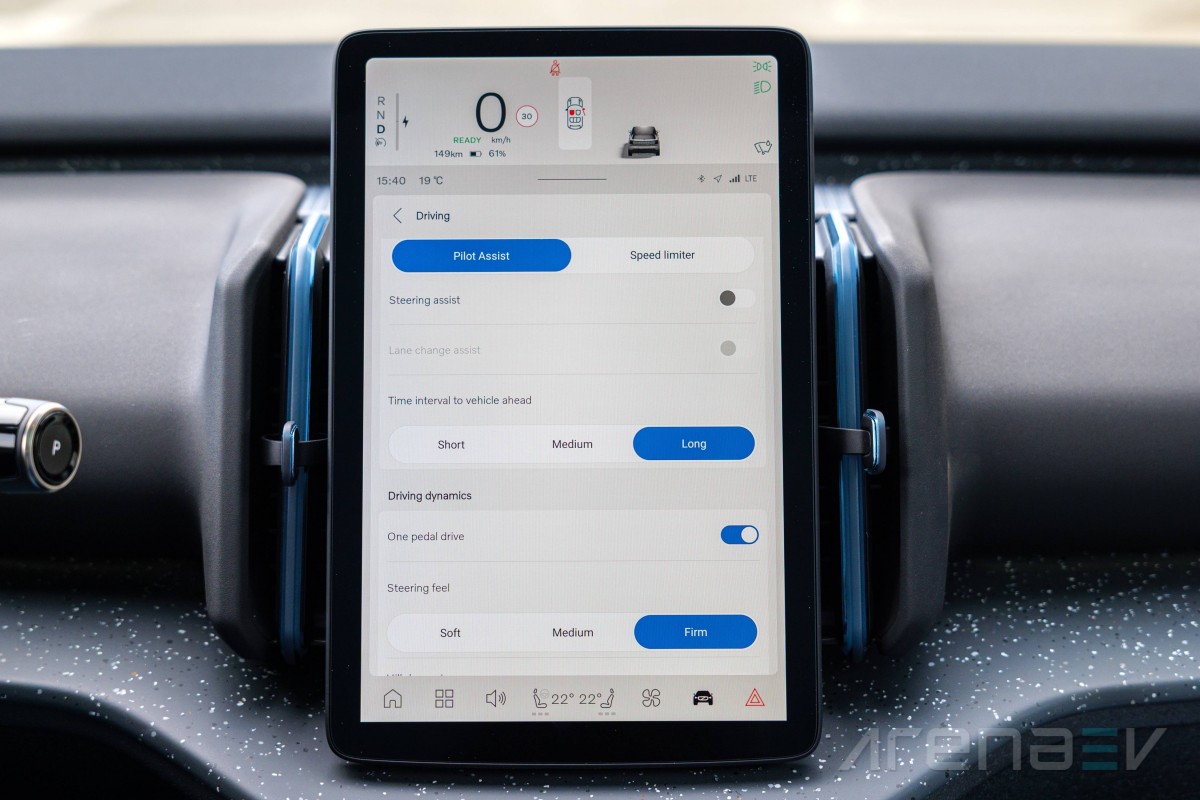
The suspension is soft and bouncy, but the huge 20-inch tires make for a harsher ride and we recommend you go with the 19-inch ones. There is a lot of body roll and the suspension gives in a lot when cornering at speed, which is far from ideal on such a quick vehicle. There are no adaptive dampers, which is a shame, but we hope this will part of the upcoming Polestar version.
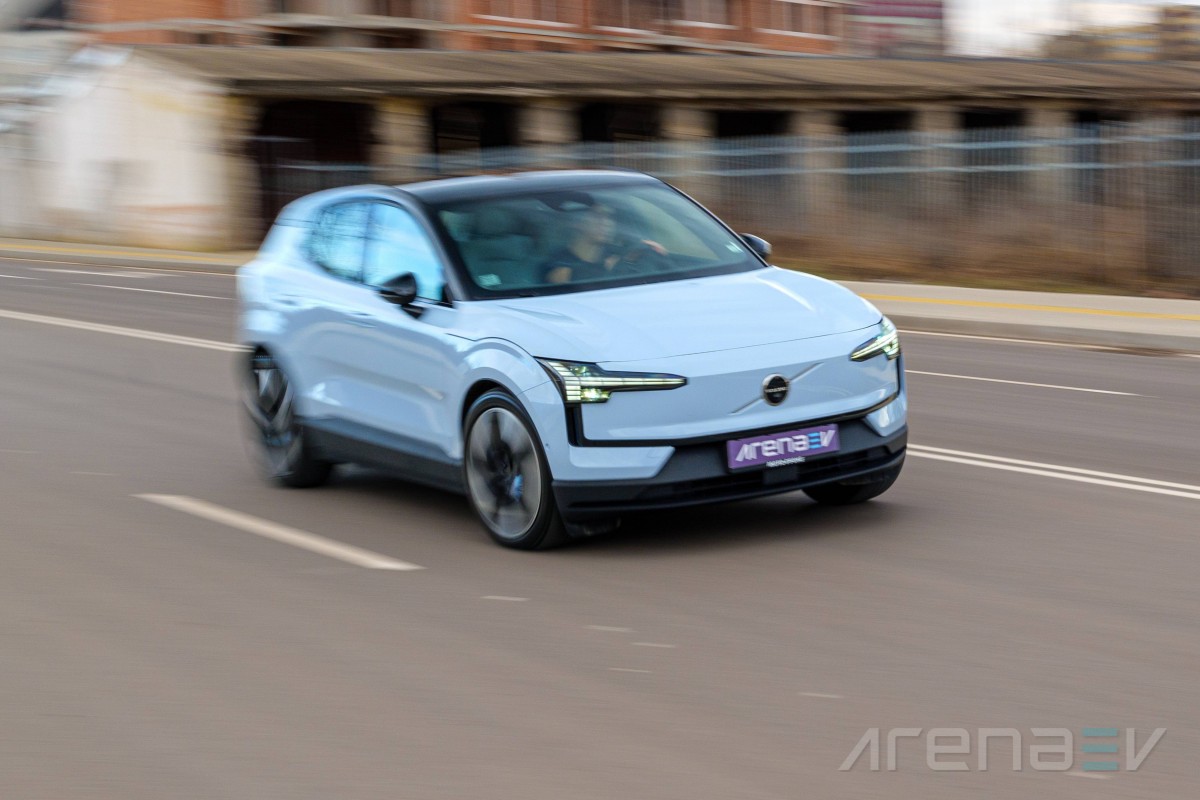
Launching from a stoplight never failed to make us happy. In daily driving there is hardly anything that’s quicker than the EX30 from a stop and smiles all around the cabin are guaranteed. While doing rapid acceleration all the time is wildly inefficient, the EX30 is so absurdly fast that you don't really care. The small EX30 certainly doesn't look so potent, making for a lot of surprised looks from other drivers.
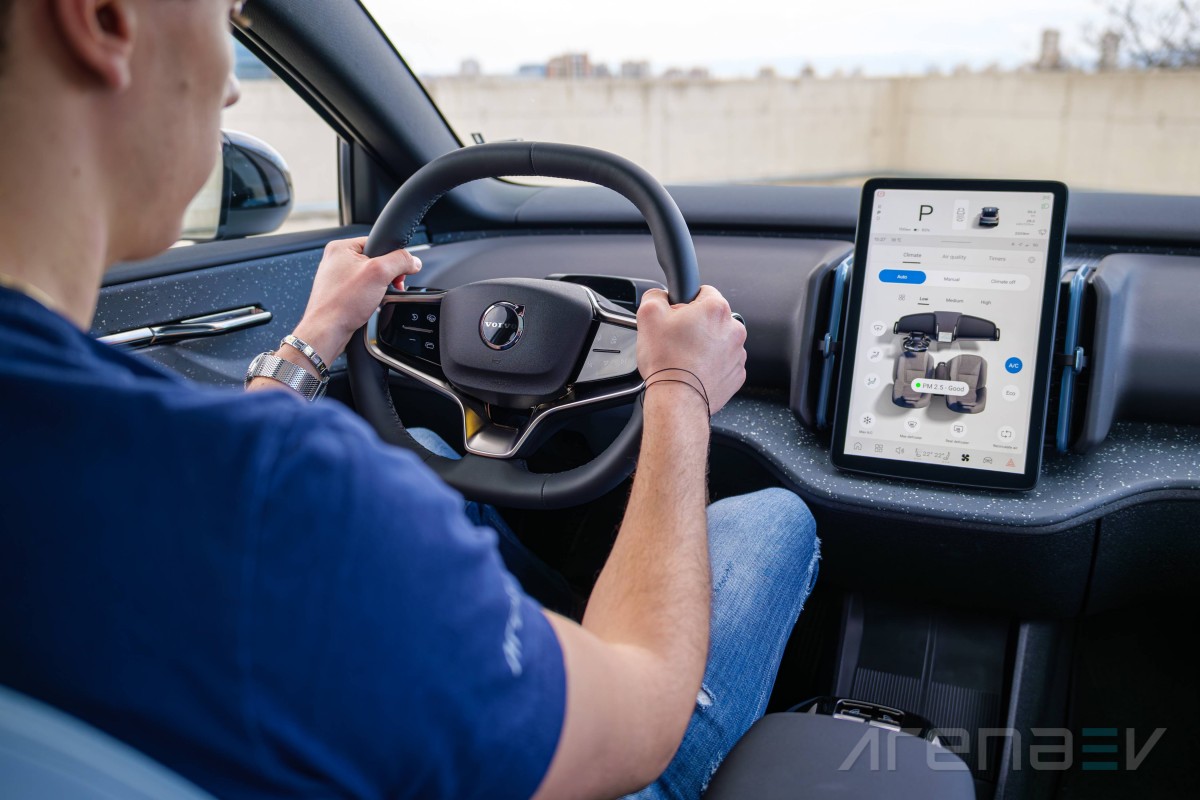
Tech features
Technology in the Volvo EX30 is on a pedestal. The minimalist approach requires a lot of the features to be integrated into the central display and Volvo has copied a lot of what Tesla does in its Model 3 and Y, which also only have a single central display and similarly barebone interiors.

The central display integrates the gauge cluster and the upper part of is always showing speed, gear and active assistants. It is harder to see since it's away from your field of view, but eventually you get used to it.
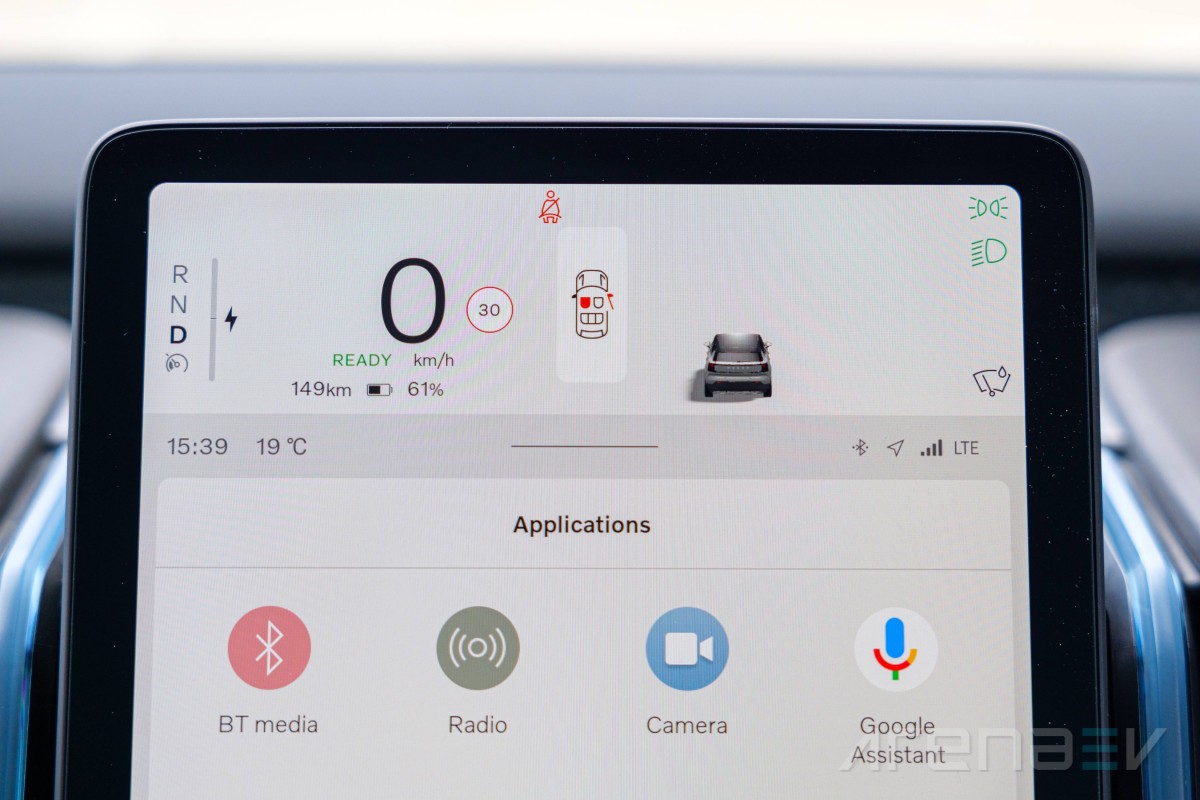
The actual infotainment takes the rest of the screen and it works fantastically. It's powered by Android Automotive and features all Google services natively, meaning that it’s very easy and intuitive to use. You can also download multiple apps from the Google Play store to enhance its functionality. Sadly, no Apple CarPlay or Android Auto is available for the model yet. This is a disappointment, since even much cheaper and lower-class models have it as standard.
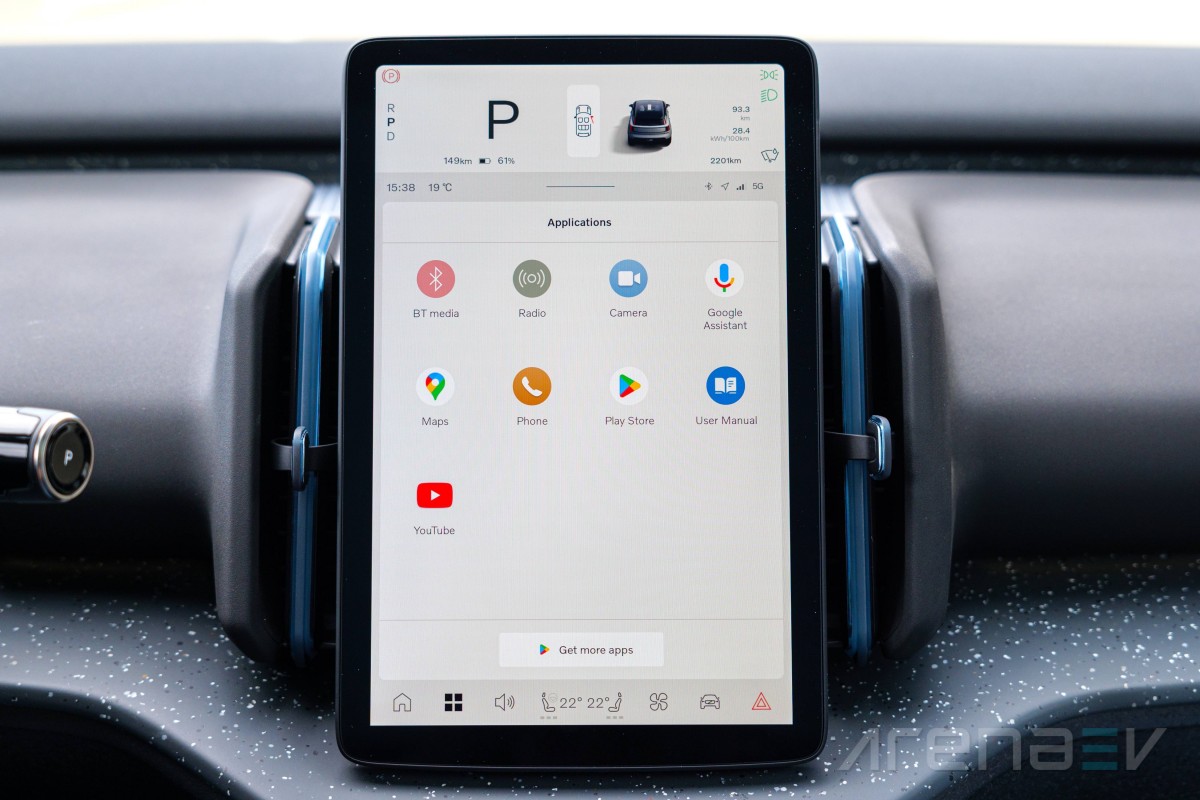
The “Harman/Kardon” sound system we had in our test car provides excellent audio quality. We also got to test the standard system, available in the base trims and truly recommend splurging on the upgrade. The base version features a single sound bar located above the dashboard and sounds like a $100 bluetooth speaker. It isn’t awful, but is obviously a cost-cutting method and far from enjoyable.
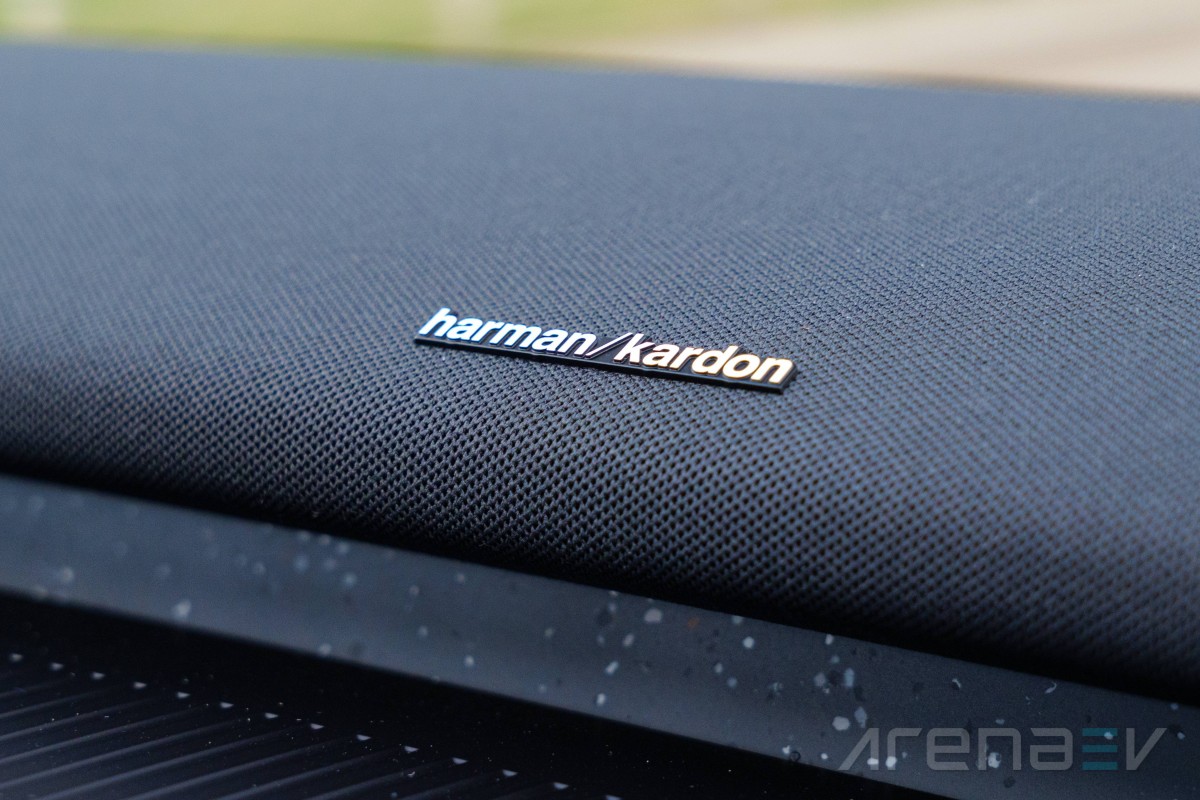
The camera system in the EX30 has great resolution and shows clear images even at night, but it lags as you move. This lag doesn’t suit a modern car and would be considered slow even in much older and cheaper cars.
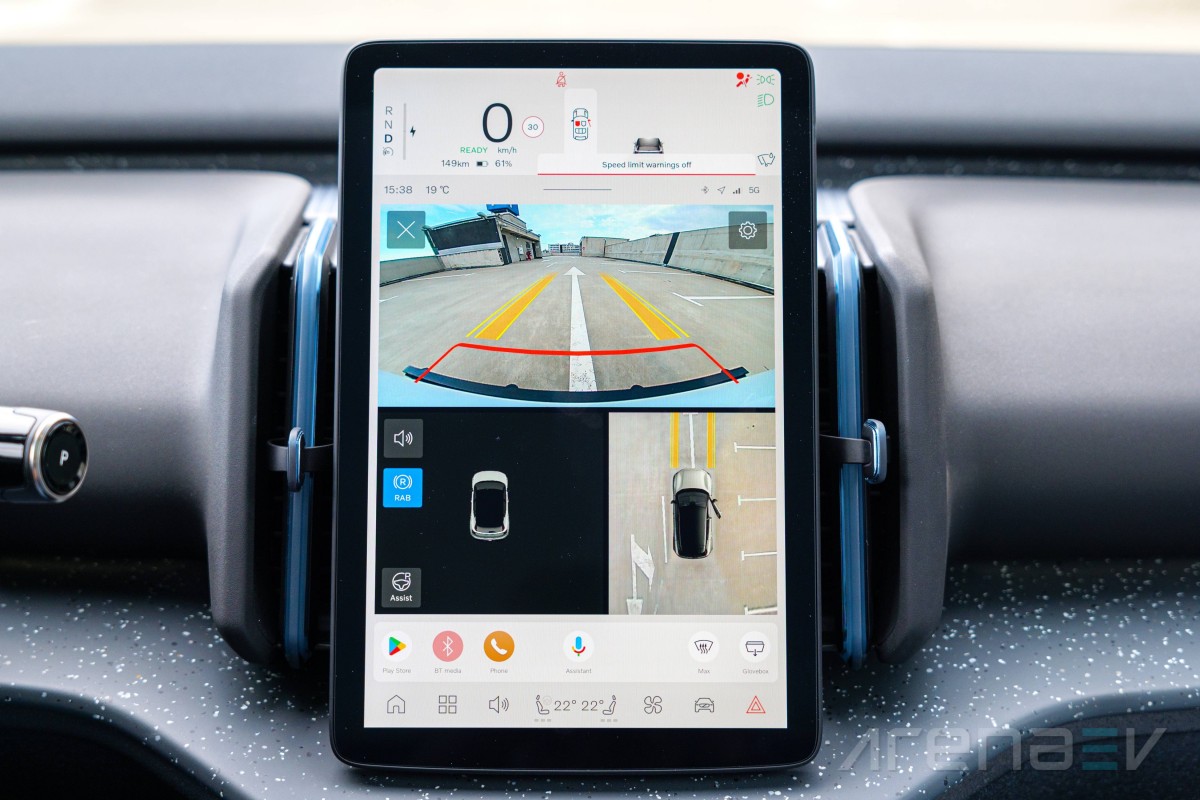
From the multimedia you can also access the charging settings and set rate limit or limit the maximum SoC. It's convenient that these important features are all separated into a single window and you can quickly change them. The trip meters and graphs are perhaps even too detailed for the average user, but all the information is easily readable and well-structured.
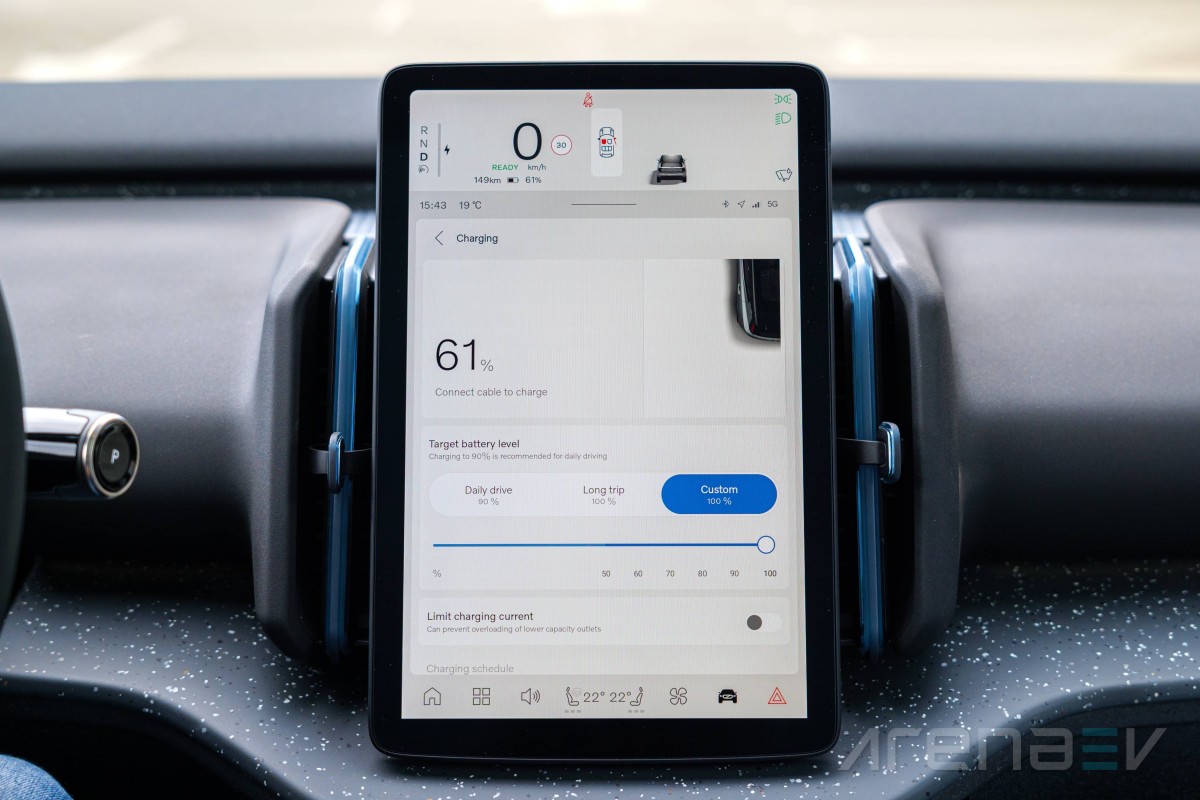
Another downside of the minimalist approach is that there are no mirror controls, so you need to use the steering wheel and the center display for adjusting those. Not only is this much slower it also cannot be done without looking, as opposed to regular buttons.
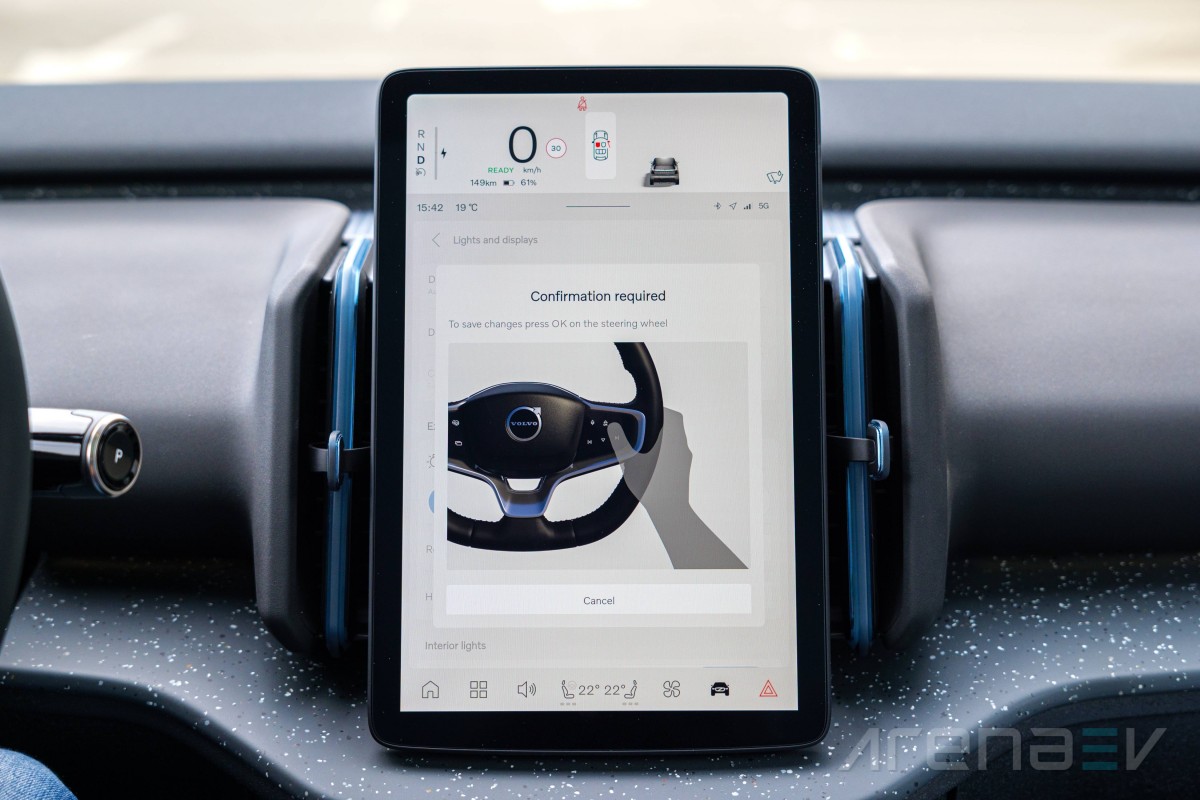
Even the light controls are integrated into the multimedia, which is borderline dangerous and completely unnecessary.
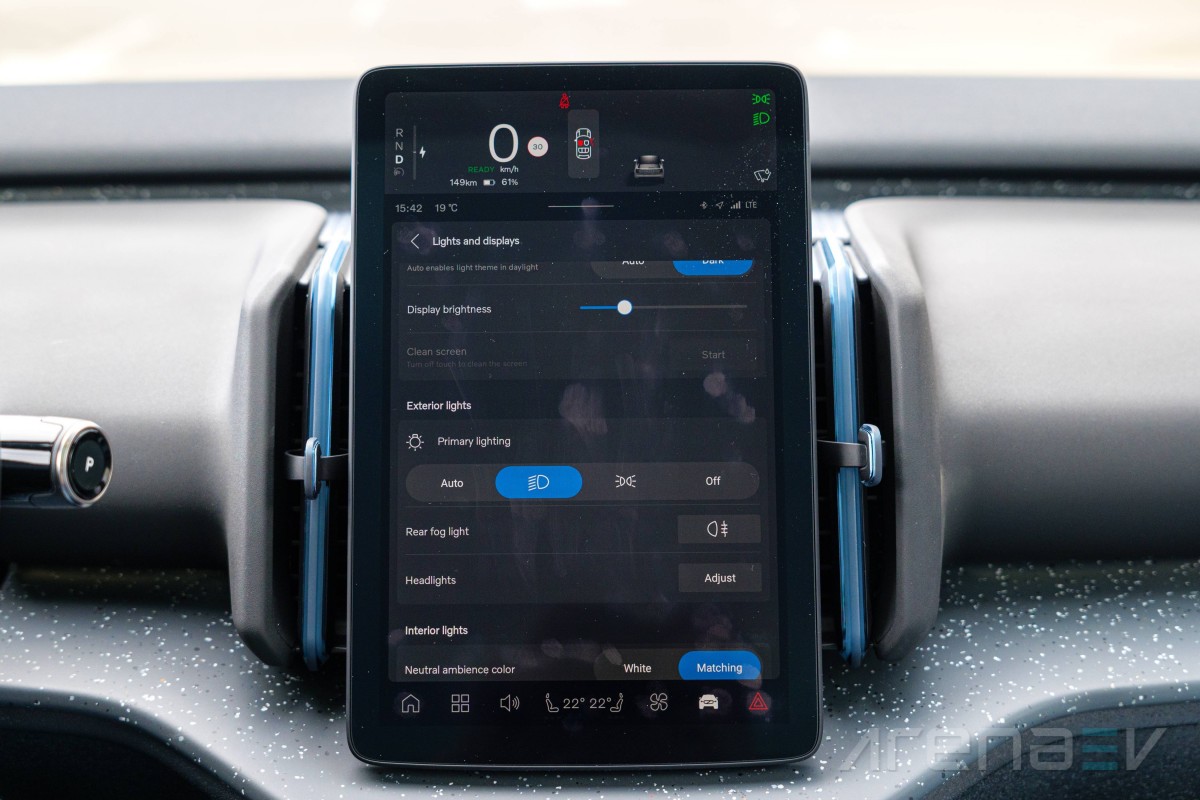
The lowest part of the center screen has a few menus that are always in place and are thus always easily accessible. You get a home button, apps button and climate control access. It’s neat that the seat controls are separated from the rest of the climate functions and can be used separately.
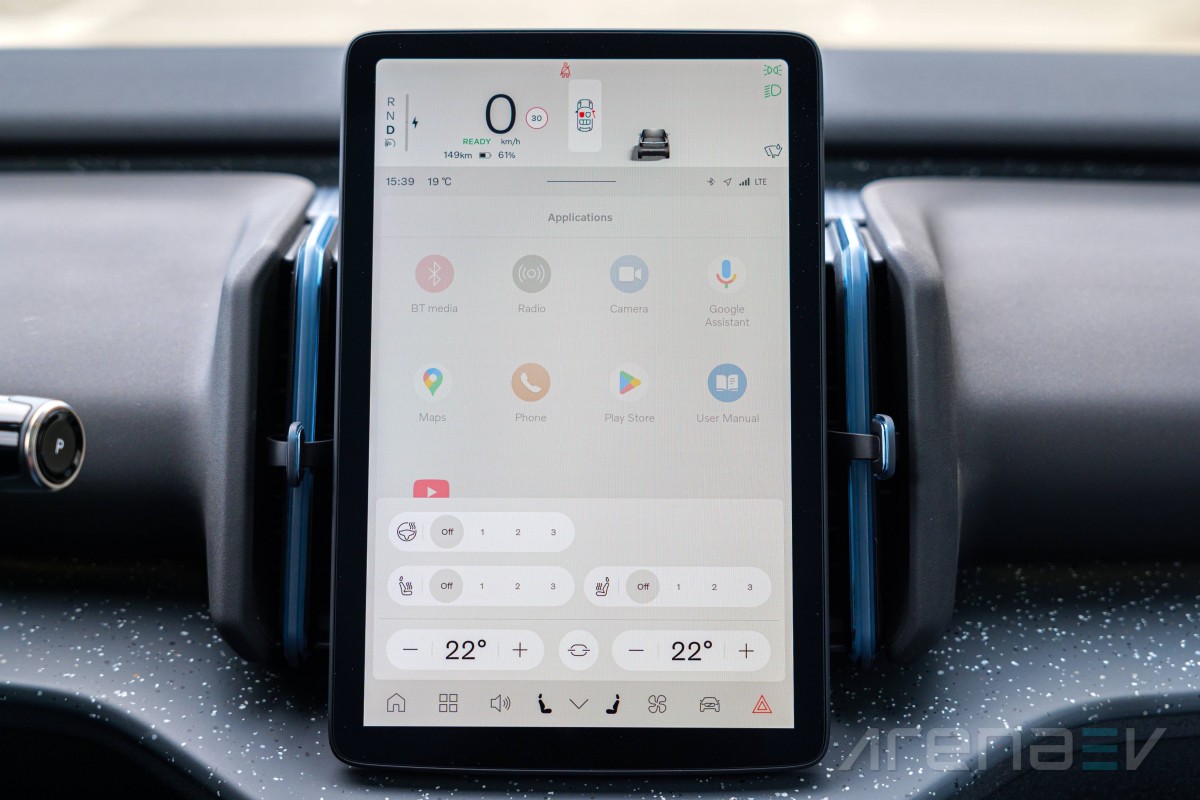
A button gives you quick access to all vehicle systems and safety features. This makes it easy to turn off all annoying assistants with just two touches and later on check on the car status as you go.
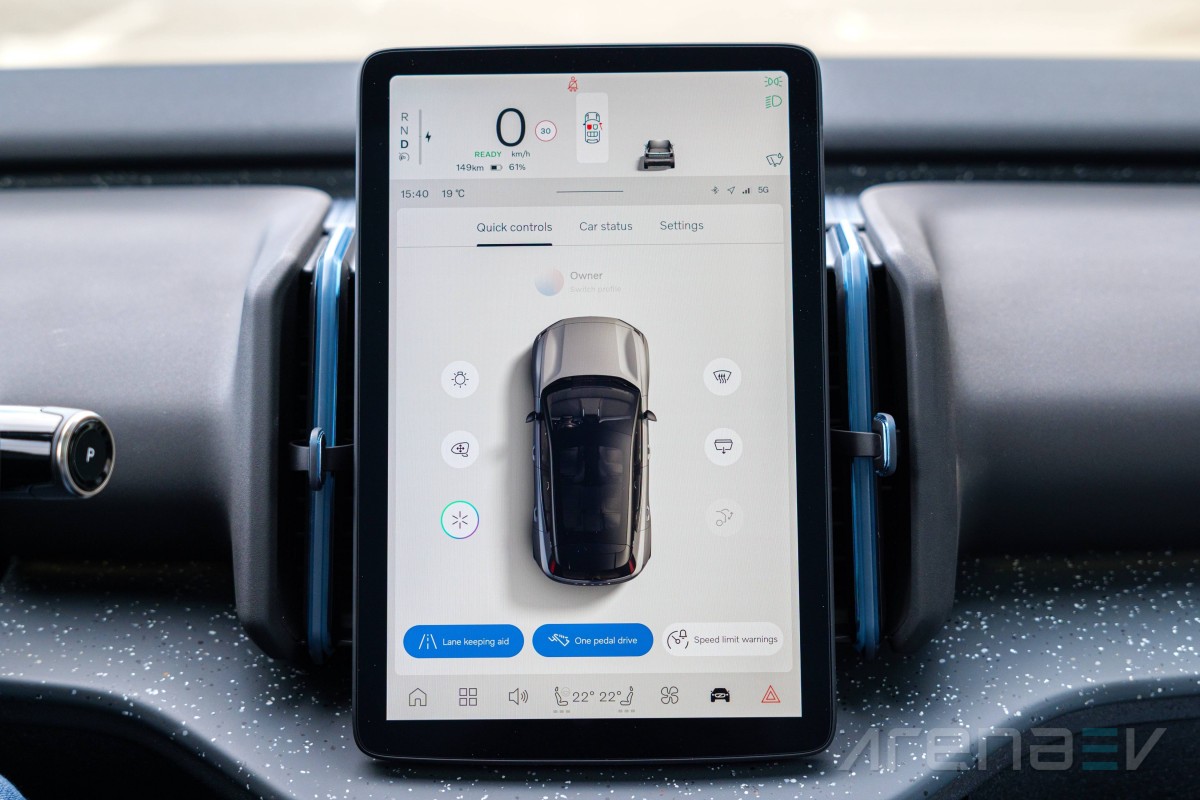
Annoyingly, the hazard lights button is at the point furthest from the driver. It is also part of the center screen and we find this rather reckless and unacceptable by a car famed for its safety. It is tiny and hard to reach, which is the opposite of what you need in an emergency. Thankfully, the EuroNCAP will no longer tolerate vehicles who have such key features as part of the infotainment screen and will lower their safety scores.
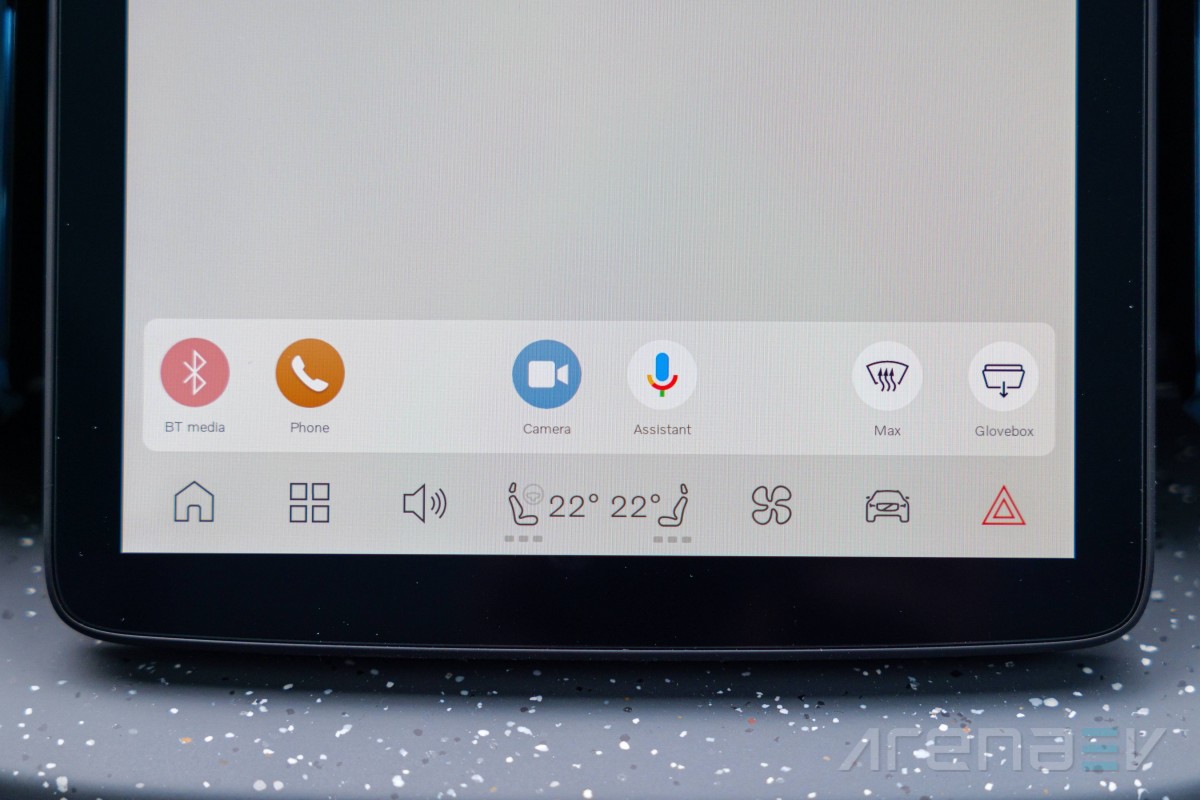
Ride comfort
The ride of the Volvo EX30 Performance is soft, yet the big 20-inch wheels make bumps feel harsh. Smaller potholes are no problems and are hardly ever felt, but bigger ones are well felt inside the cabin.
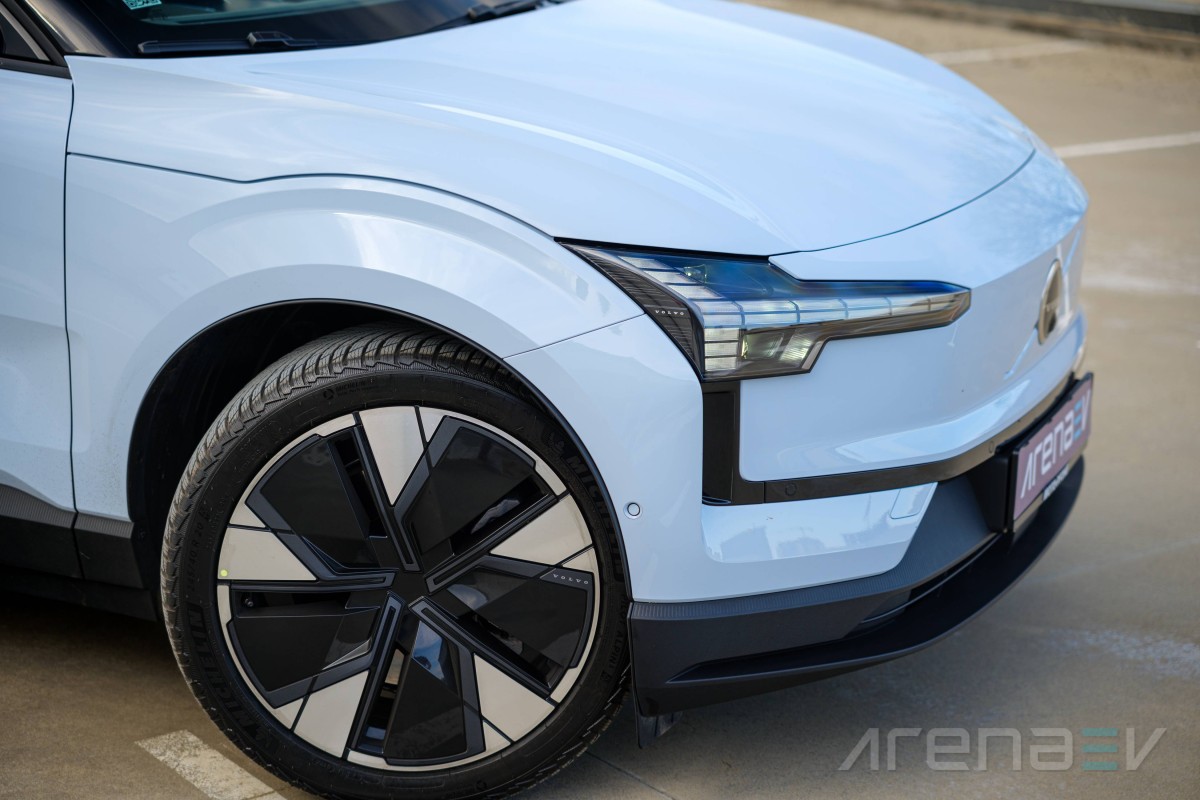
Cabin noise
The cabin of the EX30 is among the best isolated in its class. It rivals even some bigger and more premium vehicles and truly sets a cozy atmosphere inside. Wind and tire noises become apparent at higher speeds, but regular city driving is calm and peaceful.
Sound level tests are carried out with a specialized sound level meter placed in the car's cupholders. The test is conducted with air conditioning and radio off and while maintaining a steady speed.
Acceleration and braking
The EX30 can easily be described as a "pocket rocket". The advertised 3.6 seconds for 0 - 62 mph sprint are even an underestimation as we managed it in exactly 3.5 seconds, even with winter tires on. Especially in the initial acceleration to about 37 mph, the sensation is comparable to a supercar, which is a commendable feat for a small city-oriented SUV. It is an unbelievable sight when the little EX30 squats down and shoots forward at a rate you'd never expect from such a vehicle.
Braking is not as impressive, sadly, a complete stop from 62 mph taking some 38 m (124’ 8”) with the Michelin Pilot Alpin 5 tires. It's not a disastrous result, but not among the best either. And with the kind of potential the EX30 has for high speeds, we would've expected it to do a better job at stopping.
Acceleration and deceleration are measured with a RaceBox device inside the car. Testing is done with a single person inside the car, with air conditioning and traction control off.
Consumption
The Volvo EX30 Performance is among the least efficient cars in its class. Obviously, none of its competitors offer even close to that kind of performance, but the motors on the Volvo are thirsty too. If you value range highly you'll be much better off with another, less-powerful version of the EX30. For our detailed review of Volvo EX30’s consumption, check out our dedicated range test article.
We measure consumption by driving at constant speeds on an identical test route during the day. Testing is conducted with air conditioning, all safety systems and radio on. The data comes from the vehicle's board computer. Specific testing parameters such as ambient temperature are mentioned in the text on a case by case basis.
You can now use the widget below to find out the Volvo EX30 Performance's range in every combination of speed and temperature you might need. We've used our real world tests and a complex model to provide an estimate that should be as close to the actual performance as possible.
Charging speed
We managed to get the Volvo EX30 Performance charging at up to 155 kW, which is 2 kW more than what the manufacturer claims. We were also able to reach this input without preconditioning the battery, making the achievement even more impressive.
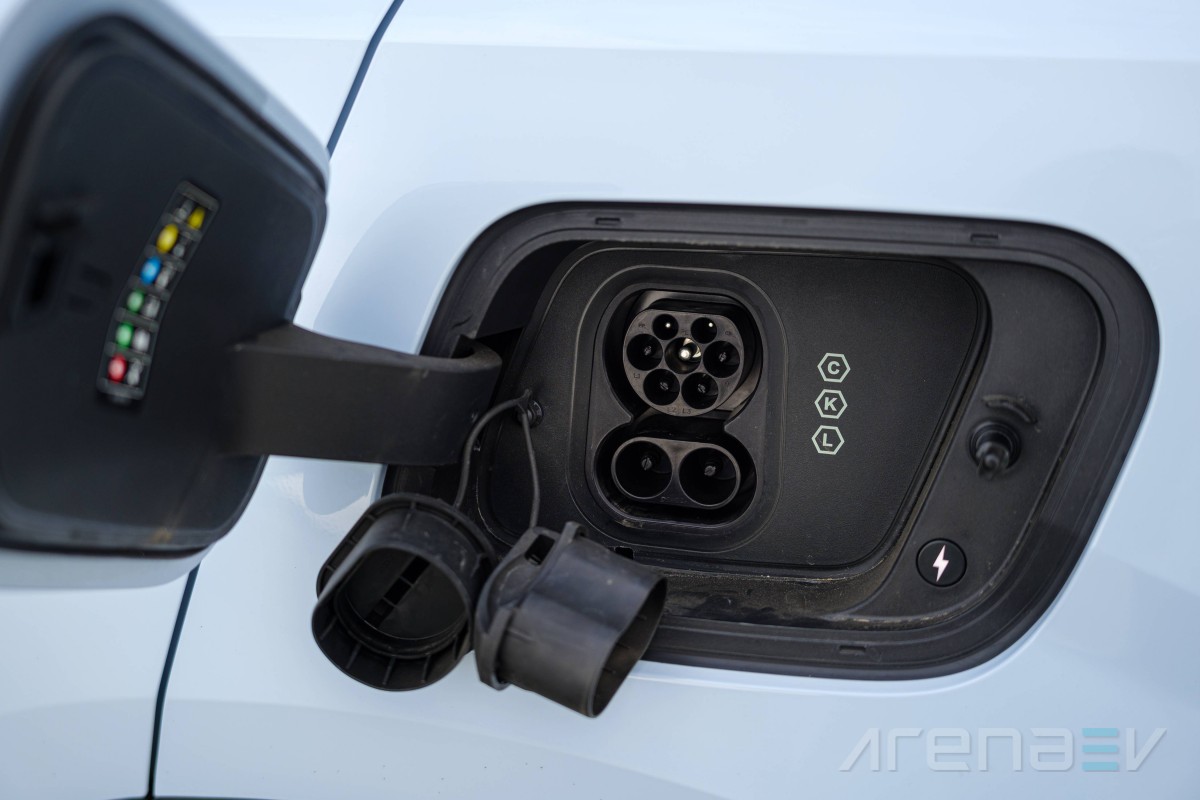
Competition
The Volvo EX30 is positioned in a highly saturated market, where almost every manufacturer participates. Volvo intends to take a piece of that pie by providing a great all-around product with the added benefit of being the quickest of the bunch. The little Swede is everything but boring, helping shift the public's perception about the brand.
The closest rival of the EX30 actually shares a platform with it and comes in the face of the Smart #1. The Smart comes with a gauge cluster and carries on multiple styling cues from its parent company - Mercedes. This is also true for the outside styling, which heavily resembles Mercedes EQ models. The Volvo reigns supreme when it comes to acceleration, even though it’s much cheaper than the #1 Brabus variant.
The second competitor is the MG 4. It has similar pricing and space inside. The MG is slightly longer and offers a larger trunk, however the built quality and overall interior design is far from Volvo's.
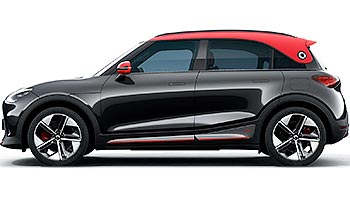
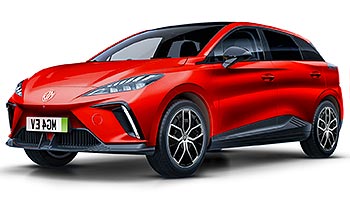
Smart #1 Brabus 2023 - • MG MG4 EV XPower 2023 -
Verdict
The Volvo EX30 Performance is an exciting car and one that is not necessarily purchased driven by rational thinking. The little EX30 excels in delivering joy when you drive it and that certainly counts for something. The amount of instant power, which kicks you in the back is a sensation that never gets old, and if you are not careful can easily get you into trouble with the law.
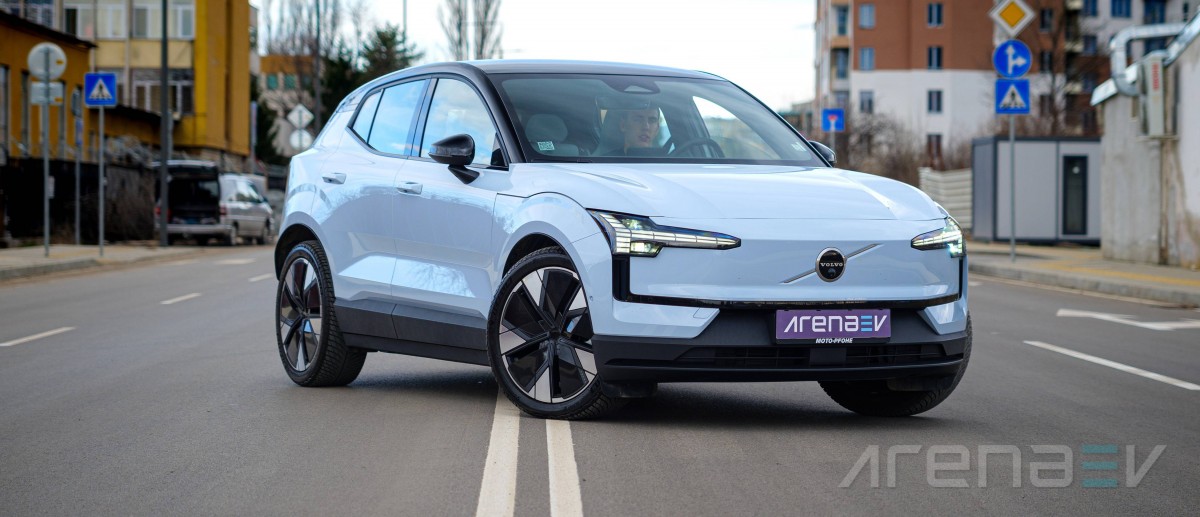
Beyonds its pefromance version the EX30 is a perfectly capable daily vehicle, serving its intended purpose of getting you around town. It offers sufficient space, adequate trunk and cutting-edge tech. It isn’t the most efficient vehicle by any means, but its great charging capabilities certainly help reduce the range anxiety.
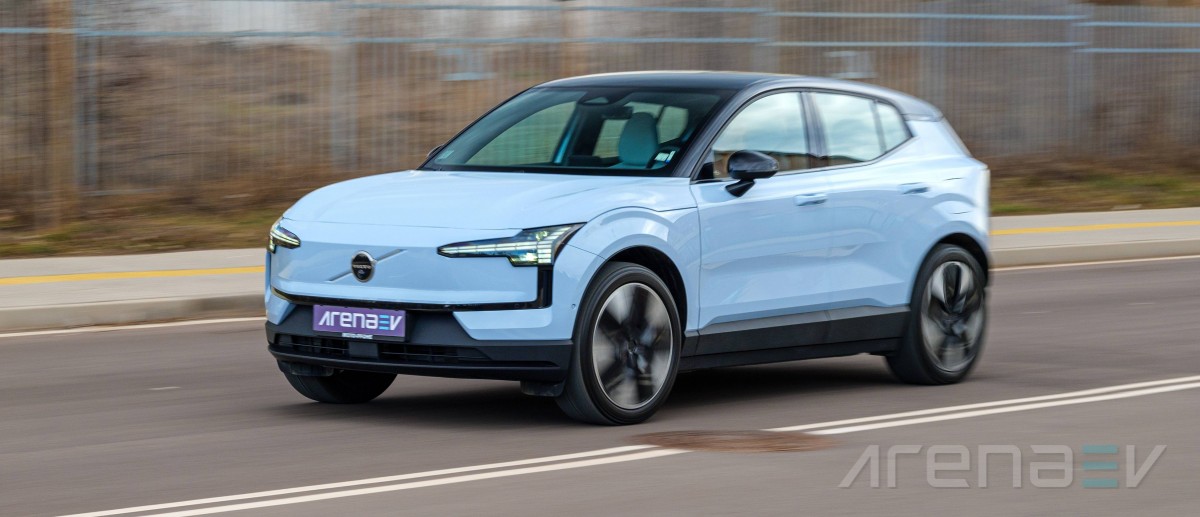
We totally get those that find the Volvo EX30 too minimalist, but they aren't the target audience for it. Instead the most powerful Volvo yet is intended for people who want Tesla’s simplicity and speed, but in a smaller package and coming from a traditional manufacturer with a fantastic dealership network and proven reliability. As such the EX30 covers a segment that should have no shortage of customers.
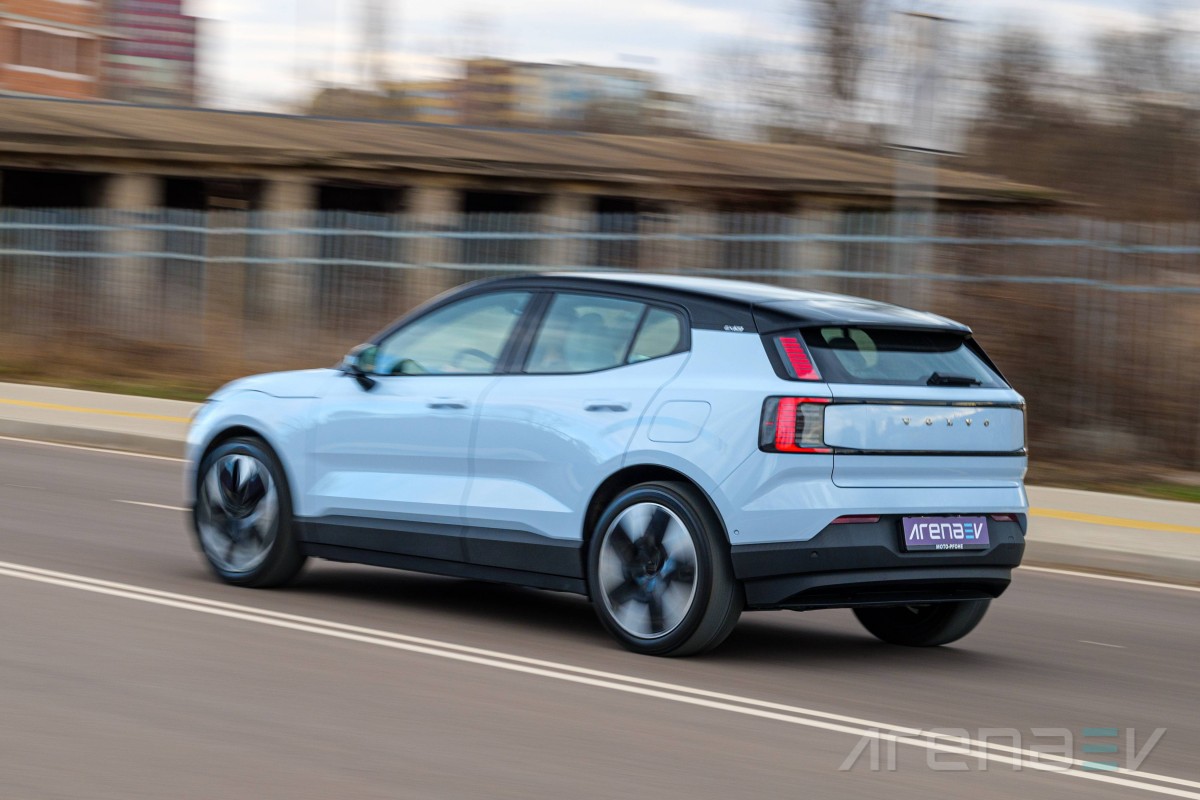
Pros
- Ridiculously quick off the line.
- Solid build quality.
- Great handling.
- Clever storage pockets throughout the interior.
- Simple to use and fluid infotainment.
- Easy to turn off driver assistants.
- Great packaging for the size.
- Comfortable seats and spacious front row.
Cons
- High consumption for the segment.
- Very cheap plastics in key places throughout the interior.
- Oversimplified interior with no gauge cluster, head-up display or physical buttons.
- Turn signal stalk always returns to initial position.
- Small trunk.
- No Apple CarPlay / Android Auto support.
- Both conventional and keyless entry are less convenient than rivals.
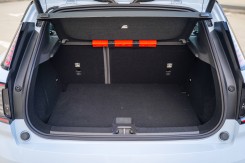
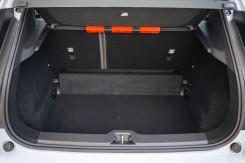

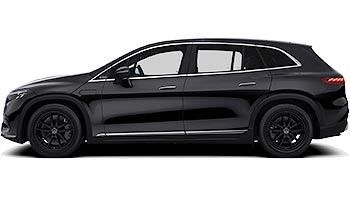
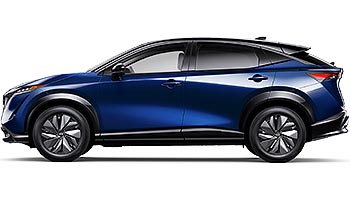
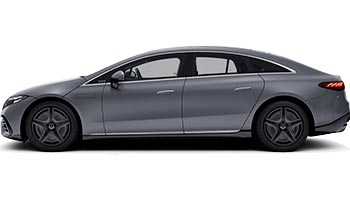
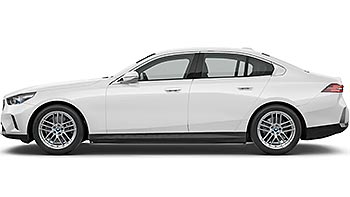

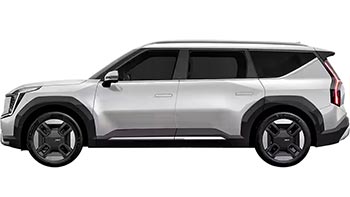
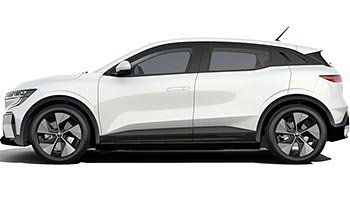
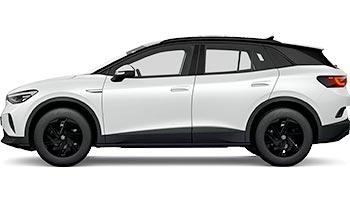
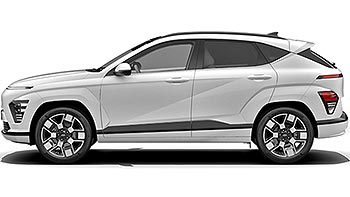
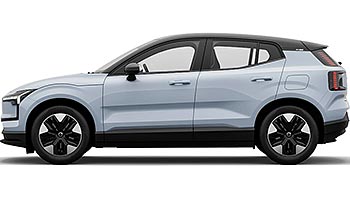
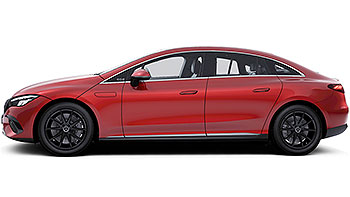
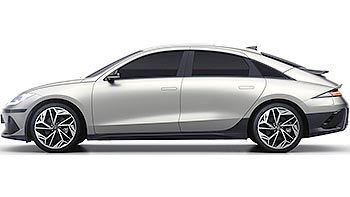
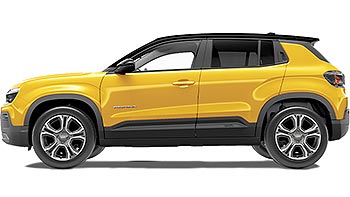
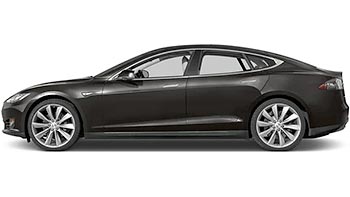
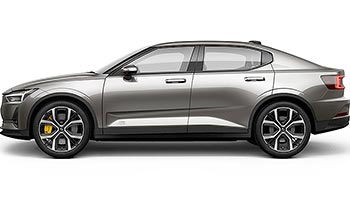
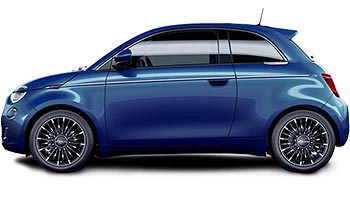
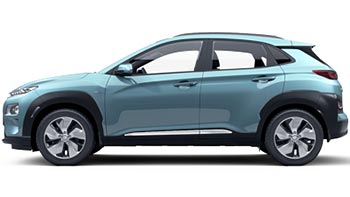
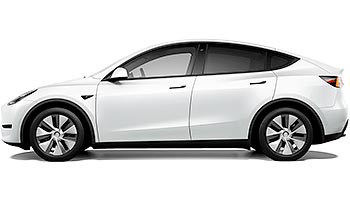





Facebook
Twitter
Instagram
RSS
Settings
Log in I forgot my password Sign up